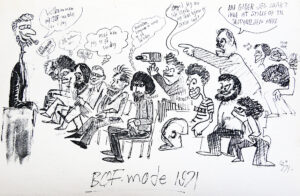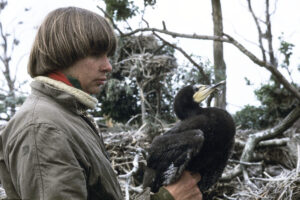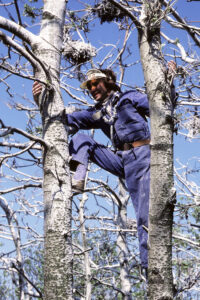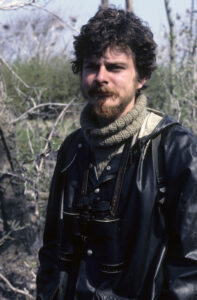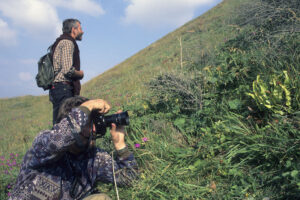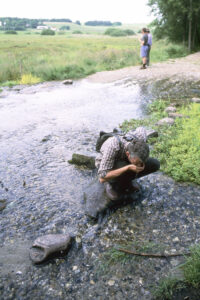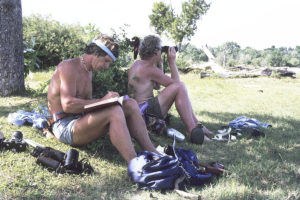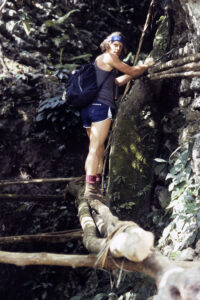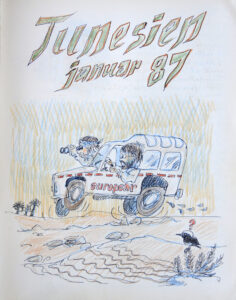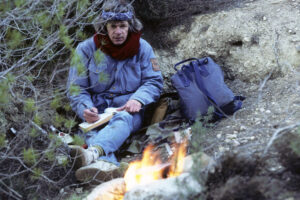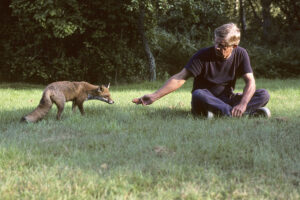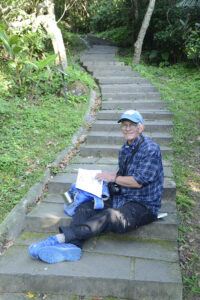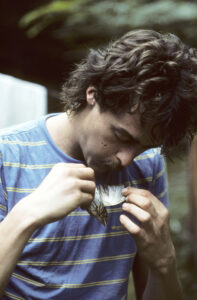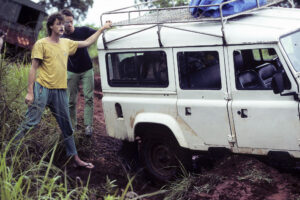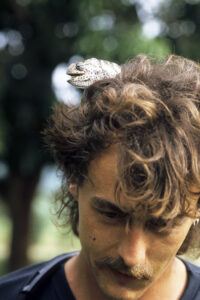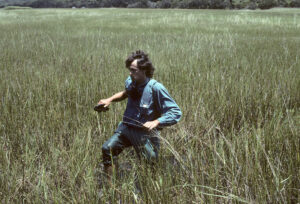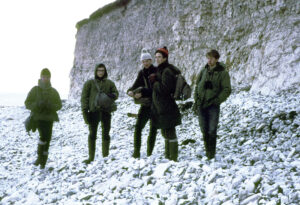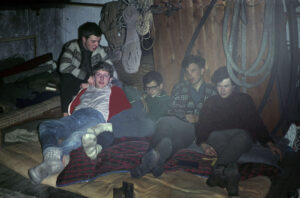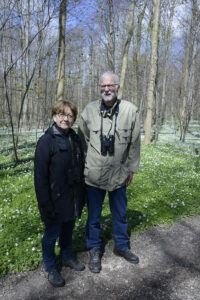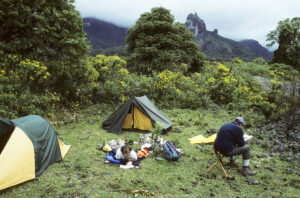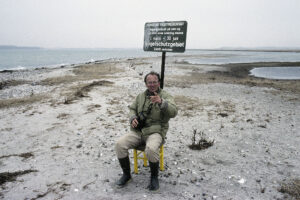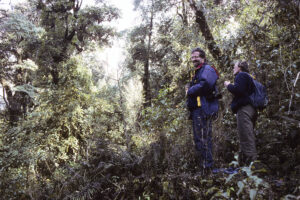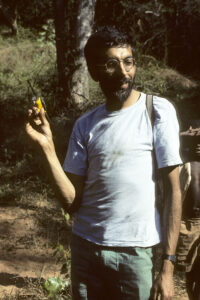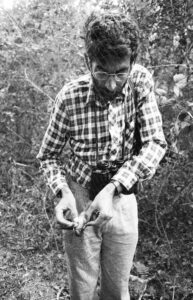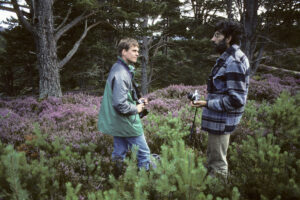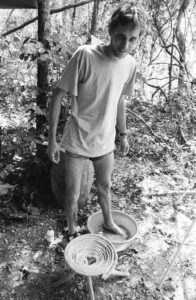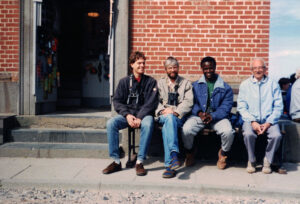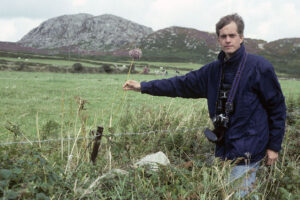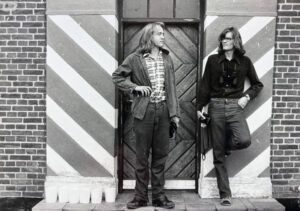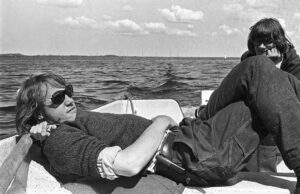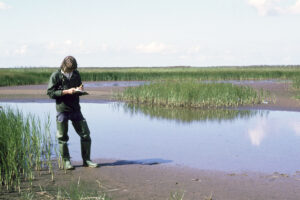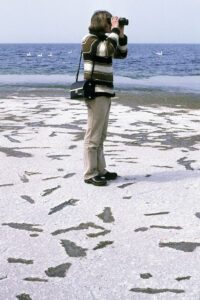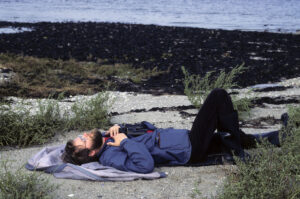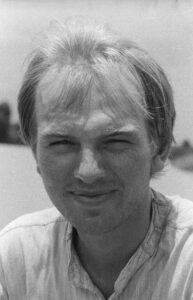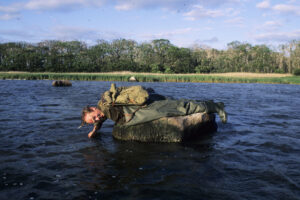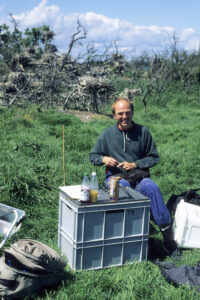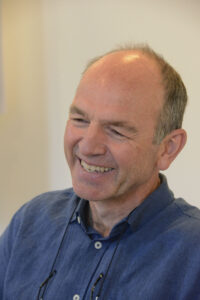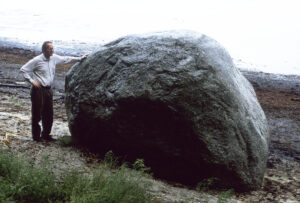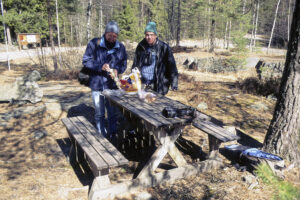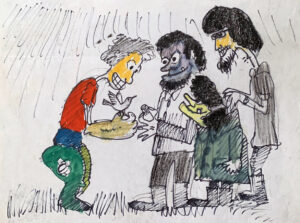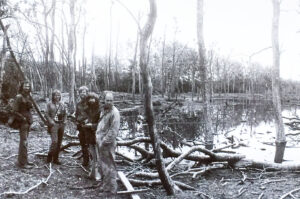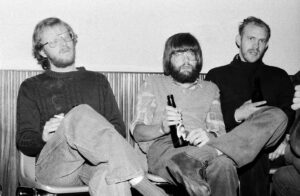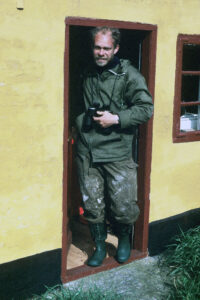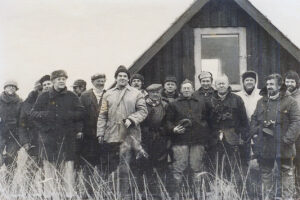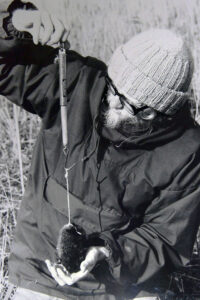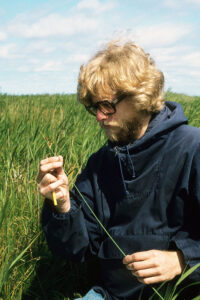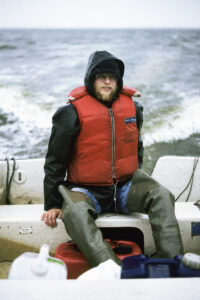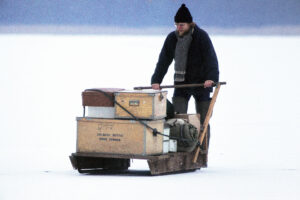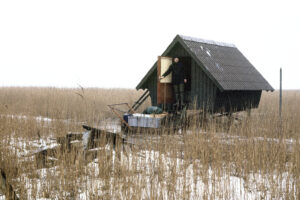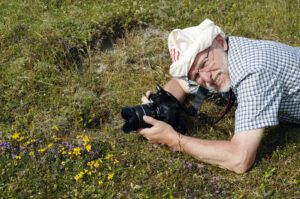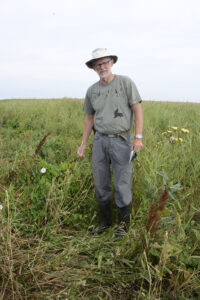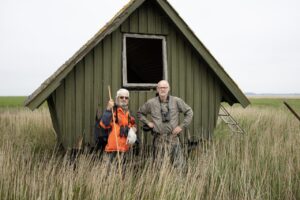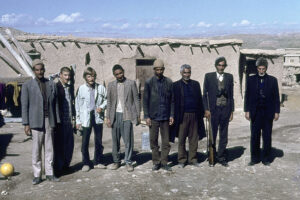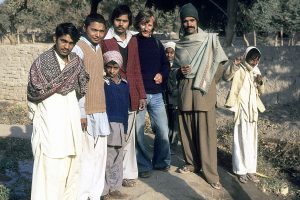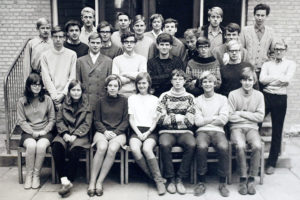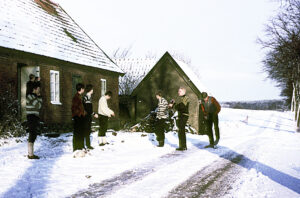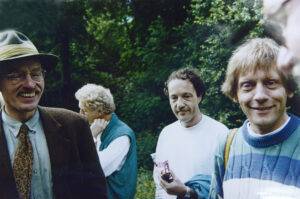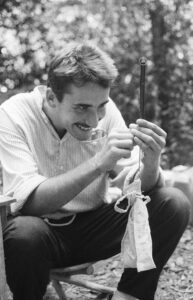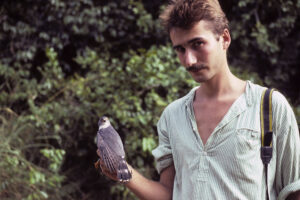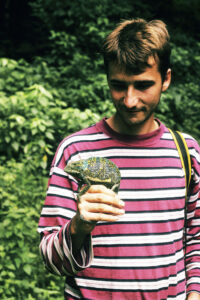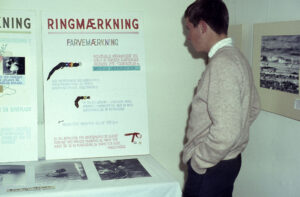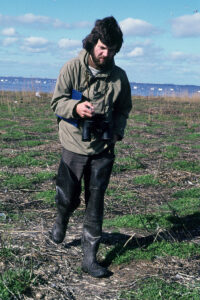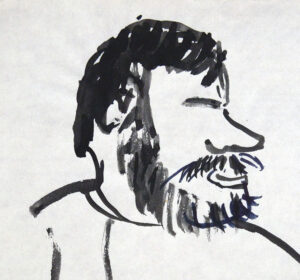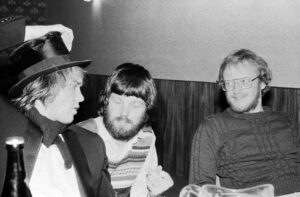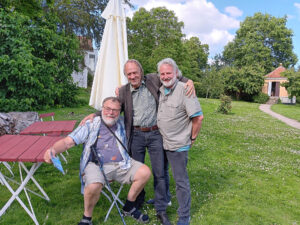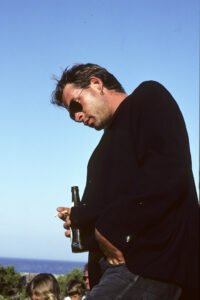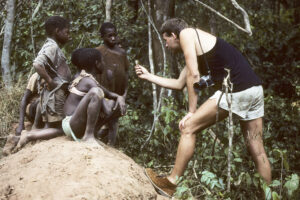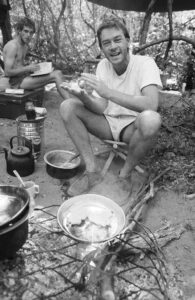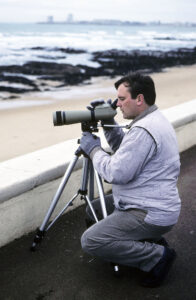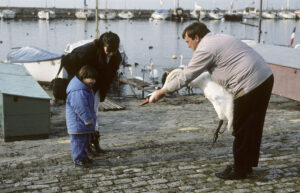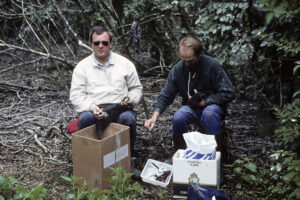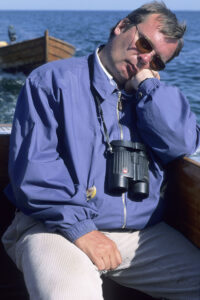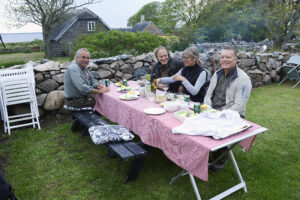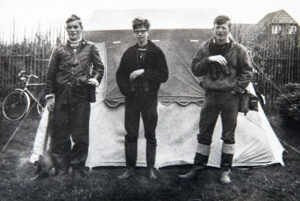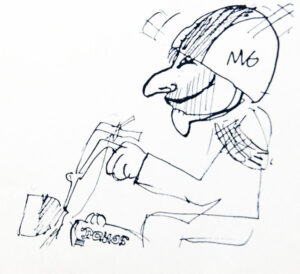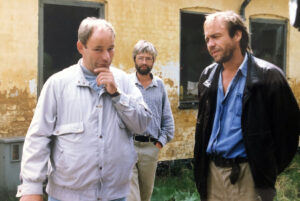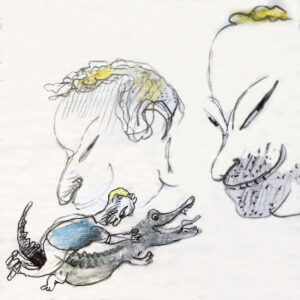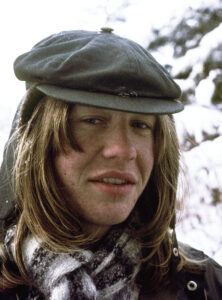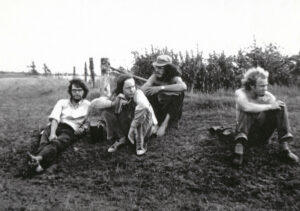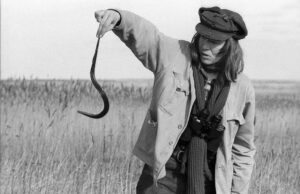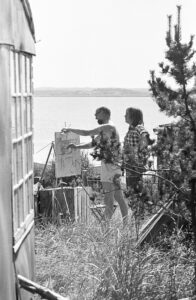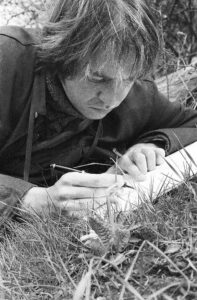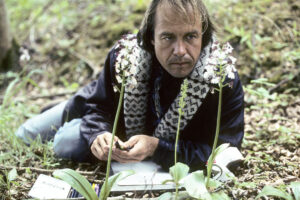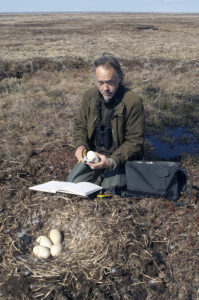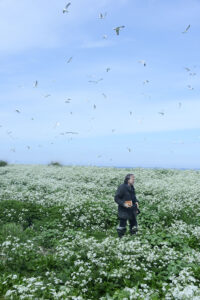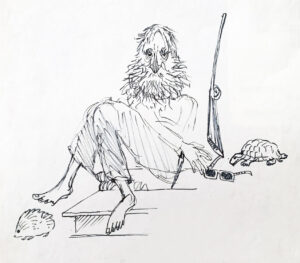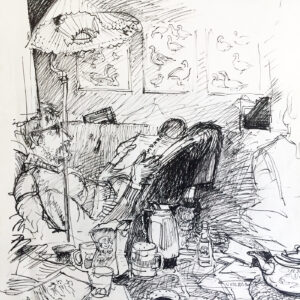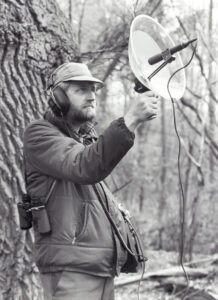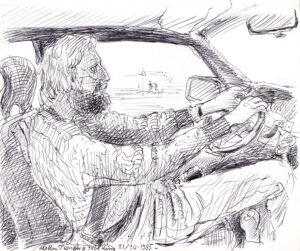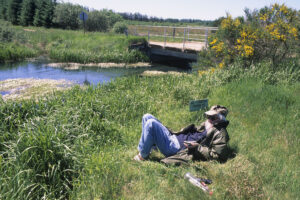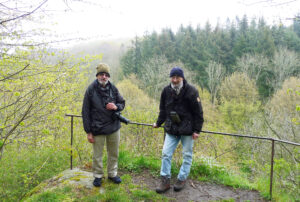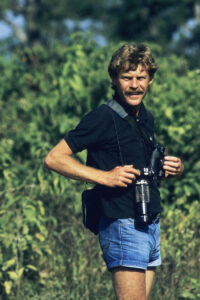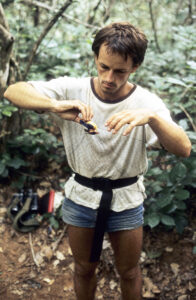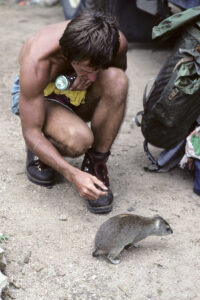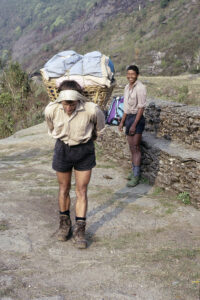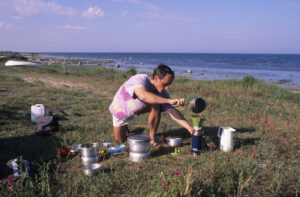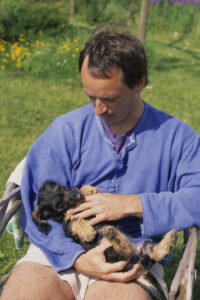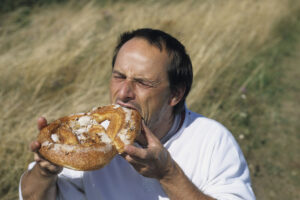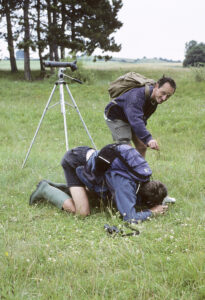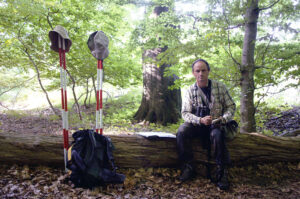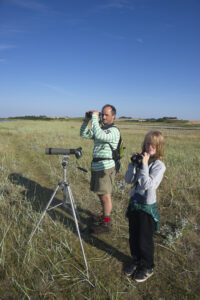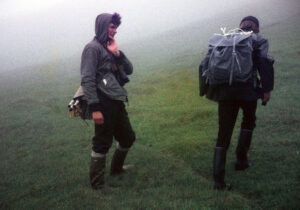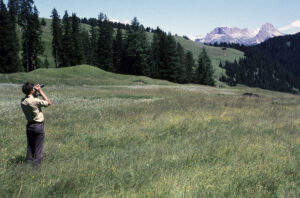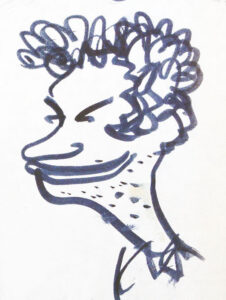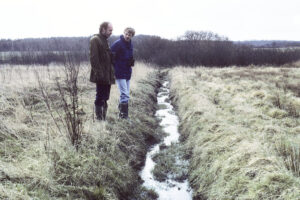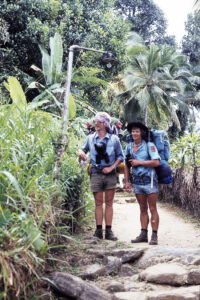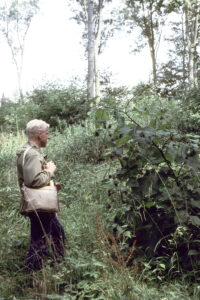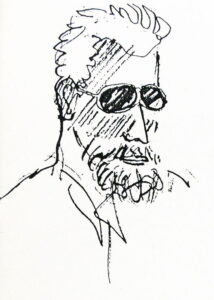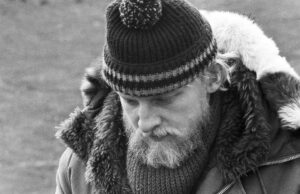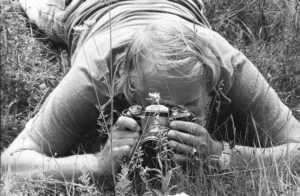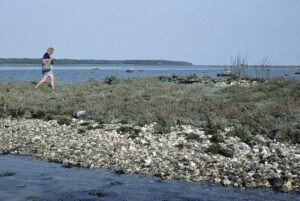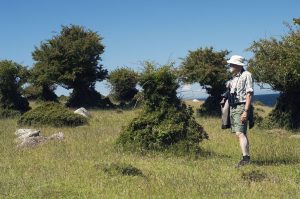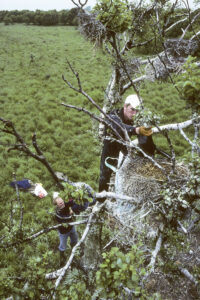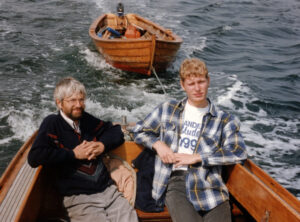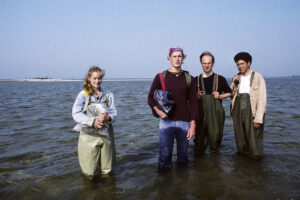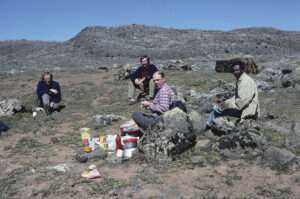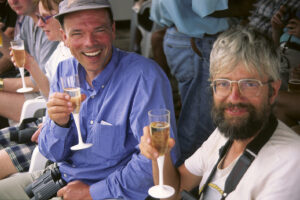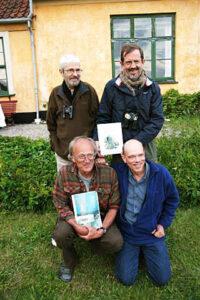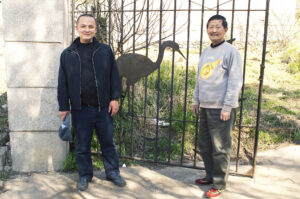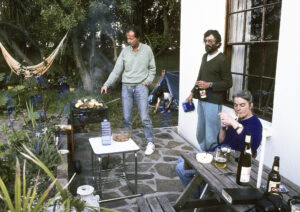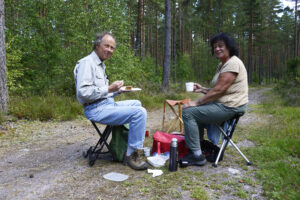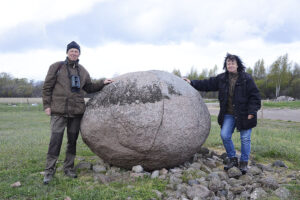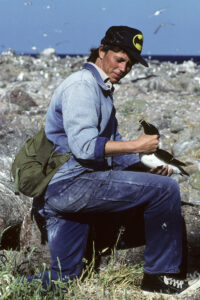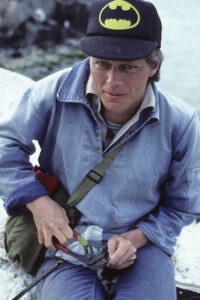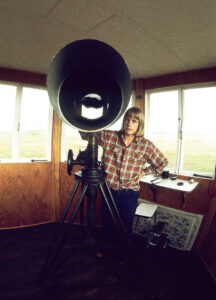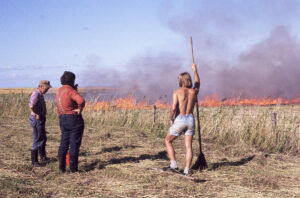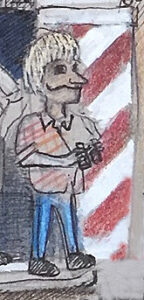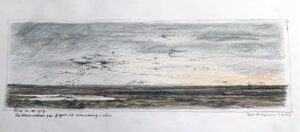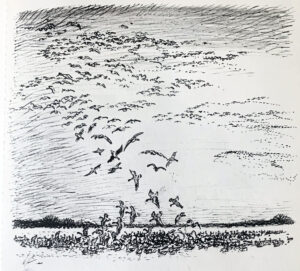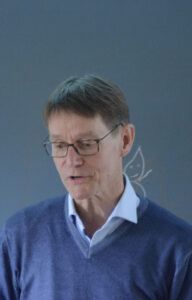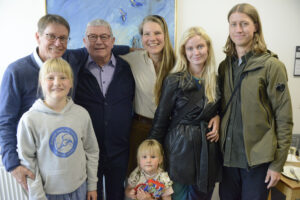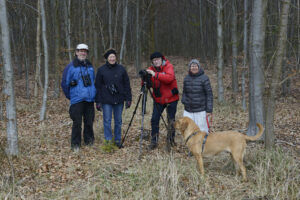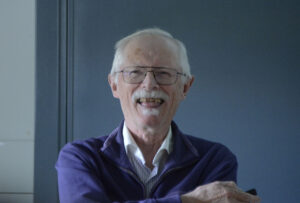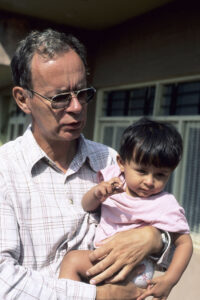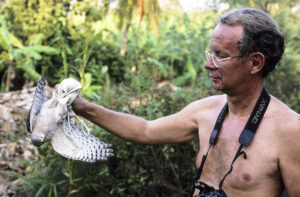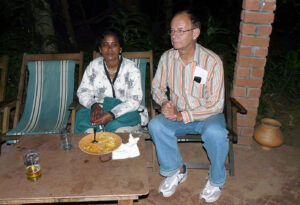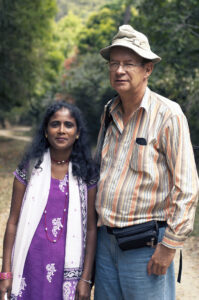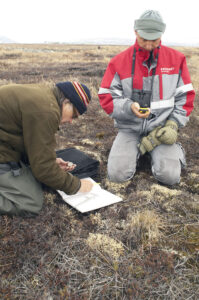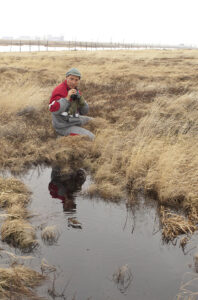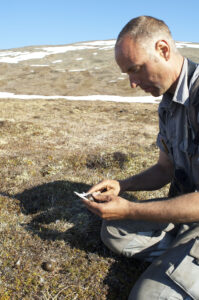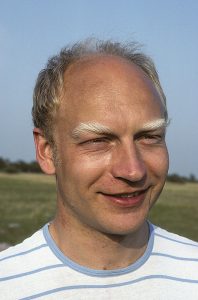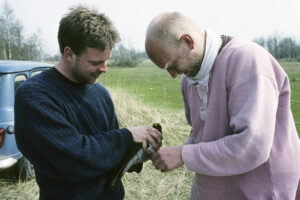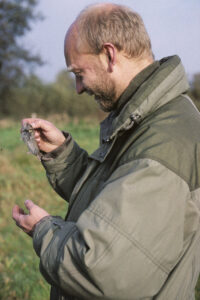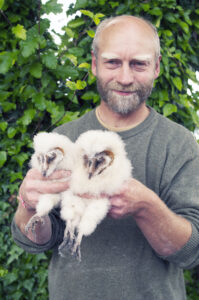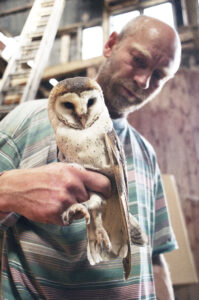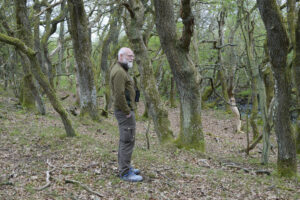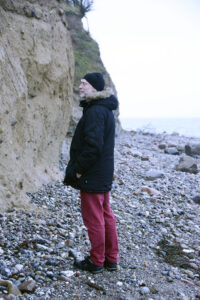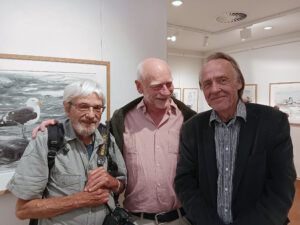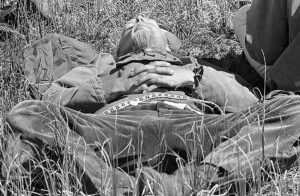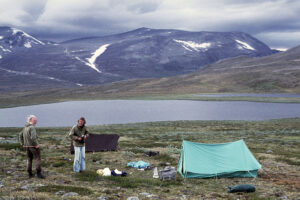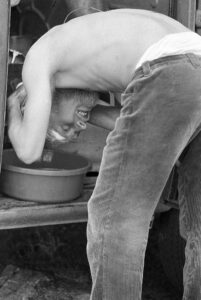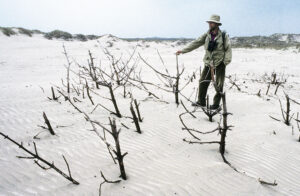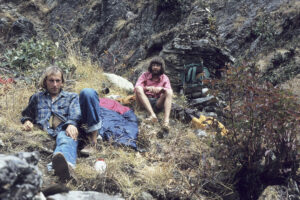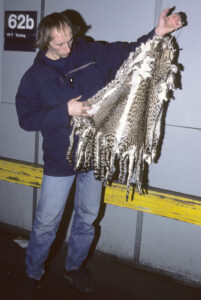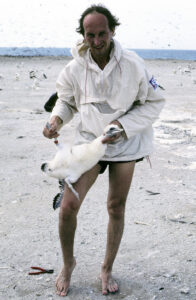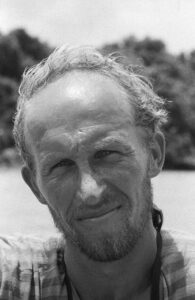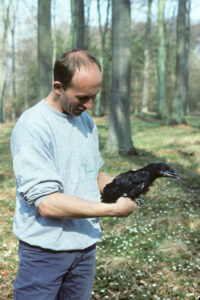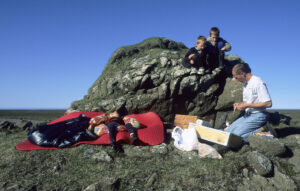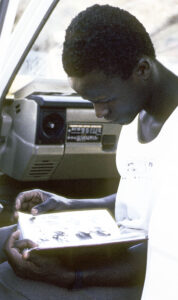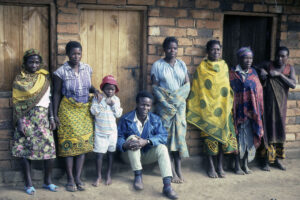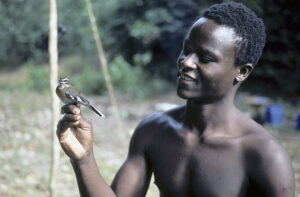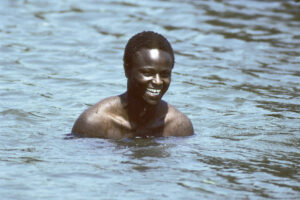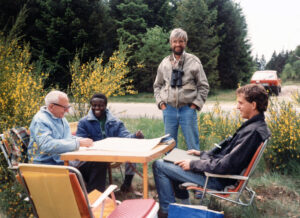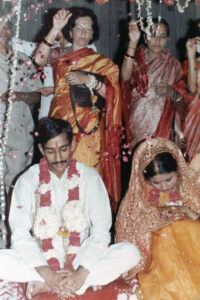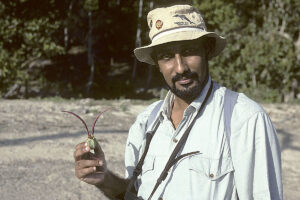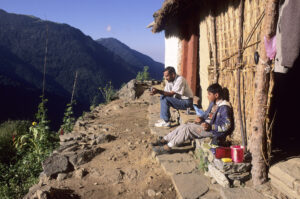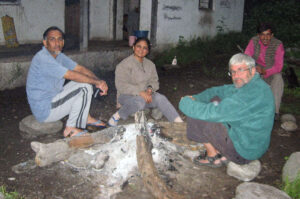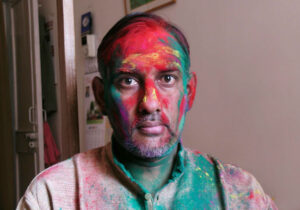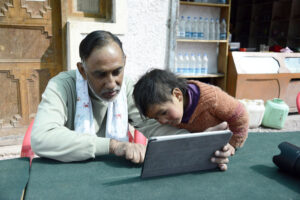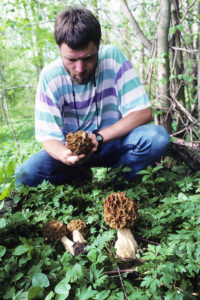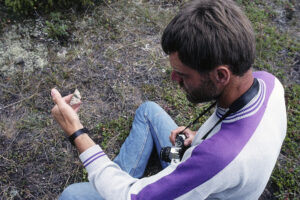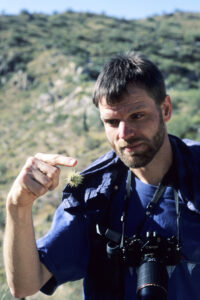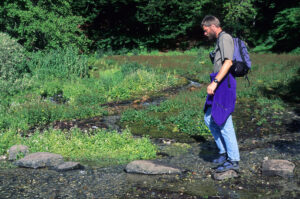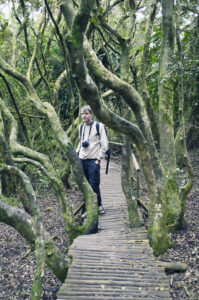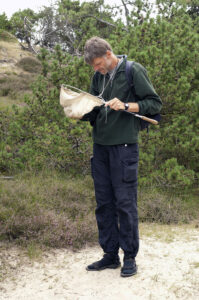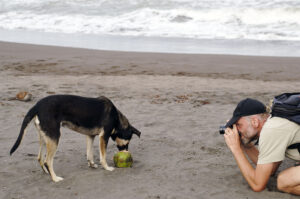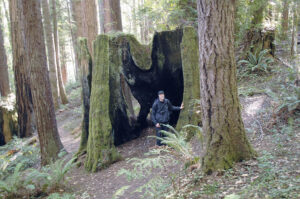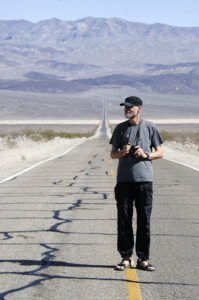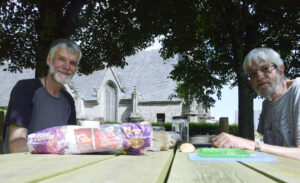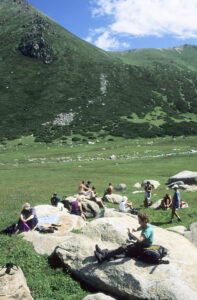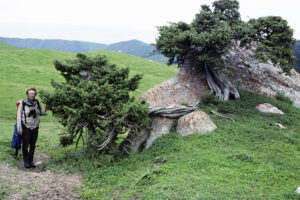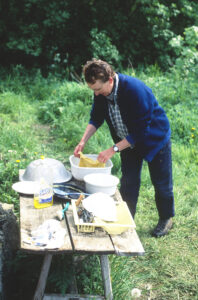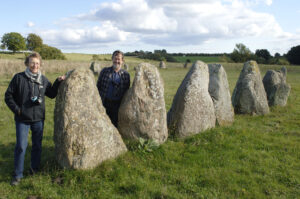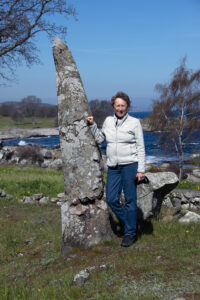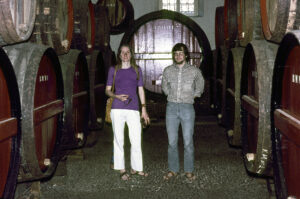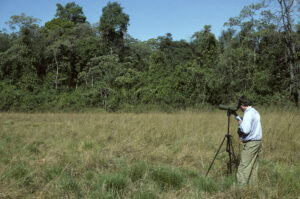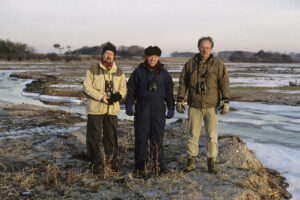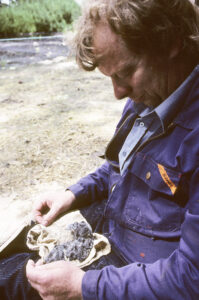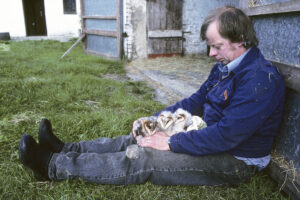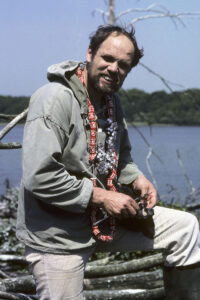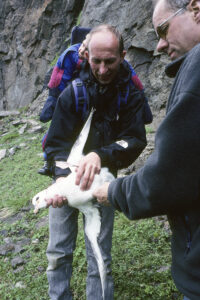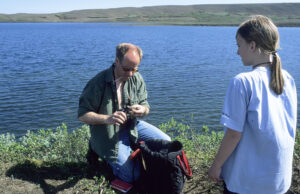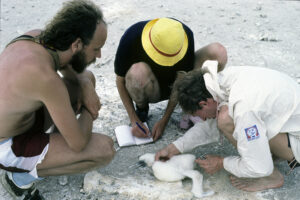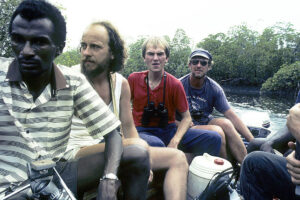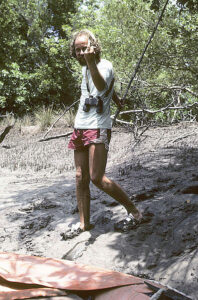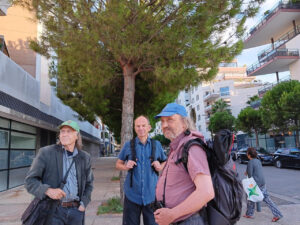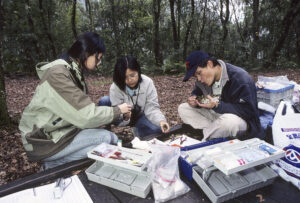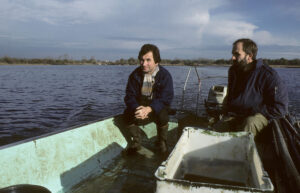Ornithologists on my way
(Drawing copyright © by Jens Gregersen)
Throughout my long life, my interest in birds has, naturally, brought me into contact with a large number of fellow ornithologists, many of them when I, in my childhood city of Århus, became a member of a club for young people with an interest in nature.
The meetings in our club were very unconventional. This is obvious from Jens Gregersen’s drawing above, which (maybe a bit exaggerated) shows a meeting in 1971. To the left our chairman, Hans-Ulrik Jensen, in the front row from left Knud Pedersen (presented below), Karsten Haug, Ulf Roed, Mogens Damm, Søren Højager (presented below), and myself, 2nd row Finn Lund Henriksen, Flemming Christensen, and Jörn Eskildsen (all presented below), and on Jörn’s knee Erling ‘Pablo’ Sørensen, standing Peter Thomsen, at the rear from left Georg Guldvang, Hans Pinstrup, Vagn Pedersen, and Henning Lykke Larsen.
I would like to thank Jens Gregersen for permission to use many of his drawings on this page.
Lars Abrahamsen, Funen, Denmark
Lars is an autodidact artist, who has specialized in producing large sculptures. I first met him around 1978 at Nature Reserve Vorsø, Horsens Fjord, where we both worked as birdwatchers for several periods 1981-1993.
Lars, ringing cormorant chicks at Lake Brændegårdssøen, Funen, June 6, 1981. This chick has a deformed bill. (Photo copyright © by Kaj Halberg)
Lars, climbing a tree in Nature Reserve Vorsø to ring cormorant chicks, May 16, 1988. (Photos copyright © by Kaj Halberg)
Lars with shot black scoters and eider ducks, Vorsø, October 18, 1992. (Photo copyright © by Kaj Halberg)
Jens Frimer Andersen, Thy, Denmark
Jens is an artist, who mostly produces water colours, depicting birds and other aspects of nature, but also ceramics, inspired by his wife Inge-Marie Fruelund. I first met him in the 1980s in Nature Reserve Vorsø, Horsens Fjord, where he participated in ringing cormorant chicks.
I visited him and his wife at their home in Thy in 1997 and 2022, and we also met by chance on the Swedish island Gotland in 1997.
Ringing cormorant chicks in Nature Reserve Vorsø, Jens was pecked in his nose, which began bleeding, May 6, 1983. (Photo copyright © by Kaj Halberg)
Jens (at the rear) and Uffe Gjøl Sørensen (presented below), studying flora at Svinklovene, Thy, Denmark, including the rare hart’s-tongue fern (Asplenium scolopendrium), June 28, 1997. (Photo copyright © by Kaj Halberg)
Jens, drinking from Ravnekilde, a very clean spring in Rold Skov, northern Jutland, June 29, 1997. (Photo copyright © by Kaj Halberg)
Niels Peter Andreasen, Møn, Denmark
Retired school teacher. Artist. Since the 1960s, he has been following the breeding peregrine falcons on the island of Møn. I first met him in 1972, when I was hired to guard the peregrine nest on the Cliffs of Møn. Spring and summer 1986 we saw each other almost daily at Naturhøjskolen, a folk high school on Møn with focus on nature. Niels was a teacher there, and I was hired as nature guide. Over the years, we have made numerous longer travels together.
Niels and Jens Holmegaard (presented below), resting at Lake Wirawila Wewa, southern Sri Lanka, January 2, 1983. Niels is busy making a sketch, and Jens is watching birds. Our trip to Sri Lanka is described on the pages Travel episodes – Sri Lanka 1982-83: The elephant charmer, and Jungle trip with Ranjan. (Photo copyright © by Kaj Halberg)
Niels on his way up towards the Gomantong Caves, Sabah, Borneo, January 14, 1985. (Photo copyright © by Kaj Halberg)
On a trip to Tunisia, January 1987, Niels and I rented a wreck of a Renault from Europcar. The petrol tank was leaking, and we had to mend it with chewing gum. (Drawing copyright © by Niels Peter Andreasen)
On a cold evening, Niels is writing diary at the camp fire, Ousseltia, Tunisia, January 4, 1987. (Photo copyright © by Kaj Halberg)
Niels, feeding a confiding, half-grown red fox, Møn, September 15, 1999. (Photo copyright © by Kaj Halberg)
In January 2020, Niels paid a visit to me in Taiwan. I met him in the airport at Taoyuan, and we drove towards the northern tip of the island. We had difficulties finding a hotel and ended up in a rather expensive motel, which, as it turned out, was a love nest for adulterous men and their mistresses. In this picture, Niels is lying in the jacuzzi. Yes, you’re right, there is no water in it. We both regard the usage of jacuzzis as a waste of water. (Photo copyright © by Kaj Halberg)
Niels, making a sketch, Bitou Cape Trail, north-eastern Taiwan, January 11, 2020. (Photo copyright © by Kaj Halberg)
Jens Bagger
Jens worked as an ornithologist in Nature Reserve Vorsø, Horsens Fjord, in periods 1983-1985, and was also ringing birds on the islet Christiansø, in the Baltic Sea, for a number of years.
In 1989, he and I, together with Thomas Bregnballe and Lars Nørgaard Hansen (both presented below), were sent to Tanzania by the Danish section of ICBP (International Council for Bird Preservation, today BirdLife International) to count wintering waders, and to ring birds in coastal forests.
Sadly, Jens died in 2012, only 50 years old.
Jens blows on the underwing of an African broadbill (Smithornis capensis) to note its moulting stage, Pugu Forest, near Dar-es-Salaam, Tanzania, January 30, 1989. (Photo copyright © by Kaj Halberg)
Our Landrover is stuck in mud on the road between Namtumbo and Tunduru, southern Tanzania, February 12, 1989. Jens and Lars are pushing. (Photo copyright © by Kaj Halberg)
During our work in Tanzania, we often found flap-necked chameleons (Chamaeleo dilepis). In this picture, Jens has placed one on his head, Narunyu, southern Tanzania, February 14, 1989. (Photo copyright © by Kaj Halberg)
Jens, wading in a swamp, Sao Hill, western Tanzania, March 11, 1989. I don’t remember, why he went out there. (Photo copyright © by Kaj Halberg)
Bent Bakkegaard, Jutland, Denmark
I went to school with Bent for 5 years, and we got our mutual interest in birds through our biology teacher, Wagner Nielsen. One day, I think it was in 7th grade, he suggested that all of us, on the following Sunday (which was our only day off), should make a trip on bicycles to a wetland about 20 km away. Everybody agreed to this idea. ”Remember rubber boots!” he said.
As the trip was going to start at 4 A.M., I expected some, especially among the girls, to stay away, but everybody showed up! A couple of the girls were wearing shoes. Wagner, as we called him, just laughed and said that they would surely get their feet wet. Off we went on our long trip, and everybody endured. On this trip, Bent and I, and another of our class mates, Peter Stougaard (presented below), became interested in birds in earnest, and in the following years we often went birding together.
Later, we went our separate ways, but Bent and I met again in 2017, when we made a nostalgic trip to Hørret Skov – a place we had visited many times back in the 1960s.
Early spring excursion to Sangstrup Klint, Djursland, March 1967. In the upper picture, Bent is standing in the centre, otherwise from left Jörn Eskildsen, Peter Stougaard, Finn Lund Henriksen, and Helge Dethlefsen (all dealt with below). The bottom picture shows Bent (left) and Jörn. (Photos copyright © by Kaj Halberg)
During the trip to Sangstrup Klint, we were allowed to spend the night in Fornæs Lighthouse, from left Jörn, Helge, Peter, Bent, and Finn. (Photo copyright © by Kaj Halberg)
Bent with a large specimen of giant puffball (Calvatia gigantea), Hørret Skov, August 2, 1968. (Photo copyright © by Kaj Halberg)
Bent and his wife Birgit on a visit to Hørret Skov, April 30, 2017. (Photo copyright © by Kaj Halberg)
Jørgen Bech, Copenhagen, Denmark
Retired physician. I first met Jørgen through our mutual friend Uffe Gjøl Sørensen (presented below), and the three of us made four longer trips together, three to Africa and one to Nepal.
In eastern Nepal, we managed to observe the colourful fire-tailed myzornis (Myzornis pyrrhoura). Jørgen says: “We regarded this bird as an icon. A mega target species. High up in the forest in Upper Mai Valley it descended to us from heaven – well, canopy, at least. There were two of them, settling in the bushes near the ground. We were happy. Birdwatchers are sometimes rewarded with moments like this.” – A picture of this bird is shown on the page Animals – Birds: Birds in the Himalaya.
Jørgen’s spiritual home is Thy, northern Jutland. As a child, he spent every summer in his grandparents’ home, and learned the local dialect. The winters were spent in Copenhagen with his parents. Jørgen has told me that his friends in Copenhagen made fun of his Jutland dialect, and his friends in Thy made fun of him, when he spoke Copenhagen dialect. So he quickly learned to switch from one to the other. Jørgen still visits Thy, and every summer he helps his family with the harvest, using an ageing Claas combine harvester.
We have also met several times in Jørgen’s summer house in western Zealand.
For more than 50 years, Jørgen has been studying the bird migration at Rørvig, northern Zealand, which has resulted in a fine book, he has made together with his fellow-birdwatchers Knud-Erik Strange and Anders Tøttrup.
Jørgen (right) and Uffe, touring the Ngorongoro Crater, Tanzania, January 1, 1995. (Photo copyright © by Kaj Halberg)
Camp life in Harenna Forest, Bale Mountains, Ethiopia, January 27, 1996. Jørgen (left) and Erling Krabbe (presented below) study bird books. (Photo copyright © by Kaj Halberg)
“Don’t do that!” – Jørgen, resting at a sign, Glænø Vesterfed, Zealand, February 22, 1997. (Photo copyright © by Kaj Halberg)
Jørgen (right) and Uffe, watching fire-tailed myzornis, Hanga Tham, eastern Nepal, February 8, 1998. (Photo copyright © by Kaj Halberg)
Jørgen, sitting beside a large species of thistle, Cirsium verutum, Jamuna, Ilam, eastern Nepal, February 9, 1998. (Photo copyright © by Kaj Halberg)
Cover of the book about bird migration at Rørvig. (Photo copyright © by Rørvig Fuglestation)
Zul Bhatia, Scotland
Zul is a Tanzanian citizen of Indian origin, who has been living in Scotland for more than 30 years. I met him in 1990 in Tanzania, where we were studying birdlife in coastal forests for ICBP (International Council for Bird Preservation, today BirdLife International). Frederik Brammer (presented below) and I also paid a visit to him in Scotland in 1992.
Zul with a dark-backed forest weaver (Ploceus bicolor ssp. stictifrons), Litipo Forest, southern Tanzania, July 5, 1990. (Photo copyright © by Kaj Halberg)
Zul extracts a tiny greenbul (Phyllastrephus debilis) from a net, Rondo Forest, southern Tanzania, July 13, 1990. (Photo copyright © by Kaj Halberg)
Zul, explaining something to Frederik, Abernethey, Spey Valley, Scotland, August 23, 1992. (Photo copyright © by Kaj Halberg)
Frederik Brammer, Brazil
I first met Frederik in 1990, when we, together with Torbjørn Eriksen and John Faldborg (both presented below), were sent to Tanzania by the Danish section of ICBP (International Council for Bird Preservation, today BirdLife International) to investigate bird life in coastal forests.
Since then, we often met in Denmark, and we made a trip together to Scotland and Wales in 1992. Later we went our separate ways, and for many years now Frederik has been living in Brazil.
Frederik, photographing blue waterlily (Nymphaea nouchali ssp. caerulea), Kilwa Masoko, Tanzania, July 2, 1990. (Photo copyright © by Kaj Halberg)
Frederik, washing his feet in our camp, Litipo Forest, southern Tanzania, July 8, 1990. (Photo copyright © by Kaj Halberg)
In summer 1991, we were paid a visit in Denmark by Nuru Benedict Sanga (presented below), our driver from the trip to Tanzania 1990. Here we are seated at the tower on Himmelbjerget (a hill in central Jutland), from left Frederik, me, Nuru, and my father Jens. (Photo Elly Halberg, copyright © by Kaj Halberg)
Frederik with a large species of onion, Ynyscaergybi (Holyhead), Mon (Anglesey), Gwynedd, Wales, August 29, 1992. (Photo copyright © by Kaj Halberg)
Thorkil Brandt, Jutland, Denmark
I first met Thorkil in 1975, when we both worked as ornithologists in Nature Reserve Tipperne, Ringkøbing Fjord, Jutland. We then made a trip together to Sweden in spring 1976. In the period 1985-1987, Thorkil was working as a birdwatcher in Nature Reserve Vorsø, Horsens Fjord, and I visited him several times there.
In 2021, Thorkil received an honorary reward from Dansk Ornitologisk Forening (Danish Ornithological Society) for his effort against construction of eight 150-metre-tall windmills at Tjele Langsø – an area, which a threatened population of about 2,500 taiga bean geese (Anser fabalis ssp. fabalis) is dependent on in winter. His effort had the effect that permission to build the windmills was not given.
Thorkil (right) and Jens Gregersen (presented below) in front of the house in Nature Reserve Tipperne, 1975. (Photo copyright © by Kaj Halberg)
Thorkil and Jens on their way by boat to count birds on islets in the southern part of Ringkøbing Fjord, June 28, 1975. (Photo copyright © by Kaj Halberg)
Thorkil, making notes during a bird count in Nature Reserve Tipperne, August 18, 1975. (Photo copyright © by Kaj Halberg)
Thorkil observing, Neptuni Åkrar, Öland, Sweden, May 3, 1976. These striking limestone rocks were named Neptuni Åkrar (‘Neptun’s Fields’), after the Roman god of the sea, by Swedish naturalist Carl Linnaeus (1707-1778), who compared the long, flat rows of rock with the long, narrow fields of the 1700s. (Photo copyright © by Kaj Halberg)
Following a bird count, Thorkil is resting on the beach, Nature Reserve Vorsø, September 22, 1987. (Photo copyright © by Kaj Halberg)
Thomas Bregnballe, Århus, Denmark
I had met Thomas a couple of times, but came to know him better in January 1988, when we, together with Ib Krag Petersen and Ole Thorup (both presented below), were sent to Tanzania by the Danish section of ICBP (International Council for Bird Preservation, today BirdLife International). The aim of the expedition was to count wintering Palaearctic birds along the coast of Tanzania. Our troubles on this trip are related in detail on the page Travel episodes – Tanzania 1988: Experiencing African bureaucracy.
When our work had been completed, Thomas, Ib, and I went on a safari trip in northern Tanzania.
In 1989, Thomas and I were both members of a new expedition to coasts and coastal forests of Tanzania, in which also Jens Bagger (presented above) and Lars Nørgaard Hansen (presented below) participated. Afterwards, Thomas, Lars, and I went on a long safari trip in northern Tanzania and Kenya.
Thomas became a biologist, and today he is the foremost Danish expert on gulls, terns, and the great cormorant. He has often hired me to do odd jobs.
Portrait of Thomas, Tanzania, February 25, 1988. (Photo copyright © by Kaj Halberg)
Thomas, hand-feeding a red-billed hornbill (Tockus erythrorhynchus), Samburu National Park, Kenya, May 14, 1989. (Photo copyright © by Kaj Halberg)
Thomas, weighing a great cormorant chick, which has just been ringed, Nature Reserve Vorsø, Horsens Fjord, Denmark, June 6, 1994. (Photo copyright © by Kaj Halberg)
Thomas, Eddie Fritze (presented below), and an unidentified person, ringing cormorant chicks, Brændegårdssøen, Funen, Denmark, June 11, 1995. (Photo copyright © by Kaj Halberg)
During a visit to the island of Ormø, southern Zealand, Denmark, to ring cormorant chicks, Thomas got cormorant dung in his hair, and is now rinsing it in saltwater on our way back to Zealand, June 18, 1995. (Photo copyright © by Kaj Halberg)
Thomas, ringing cormorant chicks, Stavns Fjord, Samsø, Denmark, May 30, 2000. (Photo copyright © by Kaj Halberg)
Thomas, Aarhus University, June 13, 2024. (Photo copyright © by Kaj Halberg)
Svend Bugtrup, Zealand, Denmark
Svend is a journalist by profession. I first met him in Nature Reserve Vorsø in the 1980s. In 1994, he and I visited several nature locations on Zealand, and in April 1997 we went to Sweden together with Søren Lauridsen to watch cranes at Lake Hornborga.
Svend at Musestenen (‘The Mouse Stone’), a glacial erratic near Vemmetofte, southern Zealand, Denmark, August 9, 1994. (Photo copyright © by Kaj Halberg)
On a cold spring day, Svend (right) and Søren take a break to eat lunch, Nature Reserve Tiveden, Närke, Sweden, April 22, 1997. (Photo copyright © by Kaj Halberg)
Flemming Christensen
I knew Flemming from childhood, as he went to school with my brother Leif, and we often visited him in his home. Later, he and I both developed an interest in birds and became members of a local club for young people with an interest in nature.
In the following years, we often went on trips together in the neighbourhood of Århus, especially at Lake Brabrand, where we ringed birds together with Jens Gregersen and Jörn Eskildsen (both presented below), and Erling ‘Pablo’ Sørensen.
In the late 1970s and early 1980s, we spent long periods together in Nature Reserve Vorsø, Horsens Fjord, where he became an expert ringer of cormorant chicks.
Flemming was killed in a traffic accident August 1984.
Ringing team at Lake Brabrand, c. 1970, from left Flemming, Jörn Eskildsen, Erling ‘Pablo’ Sørensen, and myself. (Drawing copyright © by Jens Gregersen)
Ringing team in Nature Reserve Vorsø, June 1979, from left David Boertmann, Jens Gregersen, Jens Tang Christensen (presented below), myself, and Flemming. (Photo copyright © by Lars Abrahamsen)
At the candidate party of Jörn Eskildsen, November 1979, from left Mogens Hansen, myself, and Flemming. (Photo copyright © by Jörn Eskildsen)
In 1981, Flemming and I went to Hirsholmene, a group of islands in the Kattegat Sea, to count birds. This is the house we stayed in. – May 30, 1981. (Photo copyright © by Kaj Halberg)
Here, Flemming has removed young tawny owls from the nest box to ring them, Nature Reserve Vorsø, May 4, 1984. He places them on a stick to pose for my camera. (Photo copyright © by Kaj Halberg)
Jens Tang Christensen, Vejle, Denmark
I first met Jens around 1974, when he was investigating the occurrence of small mammals in Nature Reserve Tipperne, Ringkøbing Fjord, Jutland, where I was working as a birdwatcher. In the late 1970s, he was working on a thesis on the occurrence of the water vole (Arvicola amphibius) on the island of Klægbanken, likewise in Ringkøbing Fjord, where I accompanied him several times as an assistant. Since then we have met regularly, and in 2018 and 2019 we again visited Klægbanken to investigate changes in the vegetation since the 1970s.
In the 1970s and 1980s, fox hunting was carried out in Nature Reserve Klægbanken to protect colonies of breeding birds. This picture is from April 2, 1977. Jens is standing on the far left side, Jörn Eskildsen (presented below) on the far right side. (Photographer unknown)
Jens, weighing a water vole, Nature Reserve Klægbanken, April 8, 1977. (Photo copyright © by Kaj Halberg)
Jens, investigating vegetation on Klægbanken, in this case softstem bulrush, July 22, 1978. (Photo copyright © by Kaj Halberg)
Jens in a boat, on our way from Tipperne to Klægbanken, July 8, 1979. (Photo copyright © by Kaj Halberg)
Jens on his way across the ice to Klægbanken with provisions and equipment, January 12, 1980. (Photo copyright © by Kaj Halberg)
Jens in the hut on Klægbanken, January 31, 1980. (Photo copyright © by Kaj Halberg)
Jens, taking pictures of creeping thyme and common bird’s-foot trefoil, Fanø, Denmark, July 5, 2012. It was a hot day, and as he had forgotten his hat, he tied a piece of cloth around his head. (Photo copyright © by Kaj Halberg)
Jens, investigating vegetation on Klægbanken, July 31, 2018. (Photo copyright © by Kaj Halberg)
Jens and me at the hut on Klægbanken, May 21, 2019. Here we spent countless nights during the period 1977-1980. (Photo copyright © by Thomas Bregnballe)
Arne Koch Christoffersen
My good friend Arne died in 2005. I first met him in 1971, when I was doing civil work in a forest camp. One evening, as I was playing billiard, another civil worker, whom I had not met before, approached me, saying:
”Are you the one watching birds?”
“Yes.”
”And you have planned to go to Iraq by car?”
“Yes.”
”Can I join you?”
In this way, I was acquainted with Arne, who, as it turned out, was a fellow birdwatcher. In the following years, we undertook two long journeys by car to Asia, related in depth on several Travel episodes pages on this website, see Syria & Iraq 1972: “Welcome to Baghdad!”; Iraq 1973: The hospitable mudir; Iraq 1973: Dust storm and sheep’s head; Iran 1973: In the mountains of Luristan; Iran & Turkey 1973: “Kurdistan! Bum-bum-zip!”; and Pakistan 1978: Encounter with robbers.
Arne in the town of Diwaya, southern Iraq, together with a nice guy named Hasan (right), and an agent from the ubiquitous Iraqi secret police, January 14, 1973. (Foto copyright © by Kaj Halberg)
In the mountains of Luristan, south-western Iran, we were invited to stay in the house of Muhammad, leader of the village Mirabad. In this picture, Arne is standing among men from the village at Muhammad’s farm, February 11, 1973. Muhammad is 2nd from right. (Foto copyright © by Kaj Halberg)
Arne at a spiny bush of the pea family, near Tange Fanni, Luristan, February 26, 1973. (Photo copyright © by Kaj Halberg)
In the city of Kot Sabzal, Sind, Pakistan, we changed money in a bank. Accompanied by a couple of bank clerks, we toured the neighbourhood of the city to visit local farmers. Note the jester to the right. – January 27, 1978. (Foto copyright © by Kaj Halberg)
Helge Dethlefsen, Denmark
I first met Helge in the 1960s, when I became member of a local club in Århus for young people with an interest in nature. In high school, we were in the same class. Around New Year 1966-1967, Helge and I were among a group of birdwatchers from Århus on a winter trip to Skåne, Sweden, in the area east of Malmö.
Helge once related a summer trip he and his girlfriend had made to Swedish Lappland to watch birds. Everything drowned in rain, and to avoid lying in a swamp they had to dig small canals to lead the rainwater around their tent.
Class photo, Marselisborg High School, 1967. Helge is in the back row, 2nd from right, and I am in the centre row, 3rd from right
In Skåne, we stayed in this house, named Ebbesjöstugan. Here we are gathered in front of it, Helge to the right, otherwise from left Knud Pedersen (in the doorway), Jörn Eskildsen, Finn Lund Henriksen, Karsten Haug, Peter Stougaard, Mogens Glass, and Søren Højager (all except Karsten Haug presented below). – January 3, 1967. (Photo copyright © by Kaj Halberg)
Early spring excursion to Sangstrup Klint, Djursland, March 1967. Helge is standing to the right, otherwise from left Jörn Eskildsen, Peter Stougaard, Bent Bakkegaard, and Finn Lund Henriksen (all dealt with elsewhere on this page). (Photo copyright © by Kaj Halberg)
During the trip to Sangstrup Klint, we were allowed to spend the night in Fornæs Lighthouse, from left Jörn, Helge, Peter, Bent, and Finn. (Photo copyright © by Kaj Halberg)
School class reunion at Marselisborg Gymnasium, 1994, 25 years after our graduation. Helge is to the right, far left Martin Bavngaard, then Flemming Hjortkær, and a guy from another class. I don’t know who the nose tip belongs to. (Photo copyright © by Helge Dethlefsen)
Torbjørn Eriksen, Denmark
I first met Torbjørn in 1990, when we, together with Frederik Brammer (presented above) and John Faldborg (presented below), were sent to Tanzania by the Danish section of ICBP (International Council for Bird Preservation, today BirdLife International) to investigate bird life in coastal forests. Torbjørn and I also participated in an expedition to Tanzania in 1993.
Torbjørn, weighing a tiny greenbul (Phyllastrephus debilis), Rondo Forest, southern Tanzania, July 13, 1990. (Photo copyright © by Kaj Halberg)
Torbjørn, ringing a male African little sparrowhawk (Accipiter minullus), Msumbugwe Forest, northern Tanzania, August 13, 1990. (Photo copyright © by Kaj Halberg)
Torbjørn with a flap-necked chameleon (Chamaeleo dilepis), which changed its colours remarkably fast, Rondo Forest, March 29, 1993. (Photo copyright © by Kaj Halberg)
Jörn Eskildsen, Djursland, Denmark
I first met Jörn in the 1960s, when we both became members of a local club for young people with an interest in nature. We often went on trips together in the neighbourhood of Århus, and in the summer 1966, we spent about a week together at Tinglev Mose, southern Jutland (see Knud Pedersen below).
In the late 1970s, Jörn was working on a thesis on breeding mute swans on the island of Klægbanken, Ringkøbing Fjord, Jutland, where I accompanied him several times as an assistant. In 1981, we both worked as bird watchers in Nature Reserve Vorsø, Horsens Fjord, and during a period in the 1990s, I lived with him and his wife Pia on their farm north of Horsens.
In later years, the couple has managed an art gallery, Galleri Esk, with focus on nature.
During an excursion to Sangstrup Klint, Djursland, March 1967, we were allowed to spend the night in Fornæs Lighthouse, from left Jörn, Helge Dethlefsen, Peter Stougaard, Bent Bakkegaard, and Finn Lund Henriksen (all presented elsewhere on this page). (Photo copyright © by Kaj Halberg)
Jörn, attending a meeting in Dansk Ornitologisk Forening (Danish Ornithological Society), Nyborg, Funen, November 19, 1967. (Photo copyright © by Kaj Halberg)
In the 1970s and 1980s, fox hunting was carried out in Nature Reserve Klægbanken to protect colonies of breeding birds. This picture is from April 2, 1977. Jörn is standing on the far right side, Jens Tang Christensen (presented above) on the far left side. (Photographer unknown)
Jörn, counting breeding birds, Nature Reserve Klægbanken, Ringkøbing Fjord, May 15, 1977. (Photo copyright © by Kaj Halberg)
Jörn, banding a mute swan with a plastic collar, as well as a foot ring, Ringkøbing Fjord, Denmark, October 5, 1977. (Photo copyright © by Kaj Halberg)
Jörn, sketched by Jens Gregersen in the 1970s. (Drawing copyright © by Jens Gregersen)
At Jörn’s candidate party, November 1979, from left Jens Gregersen (the only participant clad in party outfit), Jörn, and Mogens Hansen. (Photo copyright © by Jörn Eskildsen)
This picture from Nature Reserve Vorsø, 1989, shows (from right) Jörn, Mogens Glass, Jens Gregersen (both presented below), and me. (Photo copyright © by Jörn Eskildsen)
Jörn (left) together with Jens Gregersen (presented above) and Jørgen Bent Thomsen at the Johannes Larsen Museum, Kerteminde, Funen, where Jens had an exhibition of bird paintings together with Swedish artist Lars Jonsson, June 28, 2024. (Photo copyright © by Tatyana Kirikova)
John Faldborg, Denmark
I first met John in January 1988, when he, together with Jens Bagger (presented above), participated in a trip by boat to Latham Island, off Dar es Salaam (see Travel episodes – Tanzania 1988: Experiencing African bureaucracy).
In December 1988, John and I flew to Nairobi and on to the Comoro Islands, where we were supposed to wait for the boat we had used during our counts of coastal birds the previous winter (see Experiencing African bureaucracy). However, the boat was wrecked on a reef in Mozambique, and we had to return to Nairobi, and from there travel to Dar es Salaam. Together, we made a trip to Gombe Stream Reserve to see the chimpanzees there.
In 1990, John and I participated in a new expedition to Tanzania, together with Frederik Brammer and Torbjørn Eriksen (both presented above). We were sent to Tanzania by the Danish section of ICBP (International Council for Bird Preservation, today BirdLife International) to investigate bird life in coastal forests.
John and a local boat-builder, Itsoundzou, Grande Comore, December 27, 1988. (Photo copyright © by Kaj Halberg)
John, celebrating Midsummer’s Festival, Christiansø, Baltic Sea, June 23, 1989. (Photo copyright © by Kaj Halberg)
John, showing a green-backed camaroptera (Camaroptera brachyura) to local children, Litipo Forest, southern Tanzania, July 5, 1990. (Photo copyright © by Kaj Halberg)
John, baking bread in our camp, Litipo Forest, July 8, 1990. In the background Frederik. (Photo copyright © by Kaj Halberg)
Eddie Fritze, Copenhagen, Denmark
I first met Eddie in 1978 through our mutual friend Jens Gregersen (presented below), and through the 1980s and 1990s, we often met in Nature Reserve Vorsø, Horsens Fjord, Denmark. All three of us went on a trip in November 1989 to control ringed cormorants various places in France, Switzerland, and Germany, and to visit Jens’s contact persons.
I visited Eddie once in his home near Copenhagen, where he showed me his unique collection of bird rings from all over the world, and also his collection of bird craniums. As I was writing an article about cranes, he lent me a picture, taken of him when he, during the summer 1990, participated in a Russian expedition to the Daursky Nature Reserve, southeast of Lake Baikal, near the border to Mongolia. The purpose of the expedition was to catch and ring moulting cranes, especially white-naped cranes (Antigone vipio) and hooded cranes (Grus monacha). Eddie had brought about a hundred coloured and numbered plastic rings, intended for cormorants, and as the Russians until then hadn’t produced any of these rings, they invited him to participate.
Eddie’s interest in bird rings arose when he, as a boy, roamed the large garbage dump along the east coast of Amager. In those days, all kinds of garbage was just dumped in the garbage dump, and as there were many usable things to be found, a number of people, including Eddie, were scavenging the area. He noticed that some of the herring gulls, trudging around in seach of edibles, were wearing a ring around one leg. These rings allured him, and he thought a lot about how to get hold of them.
Then he got a brilliant idea. He put on some old clothes and working gloves, put a paper sack over his head with two peepholes for the eyes, and then dug himself down among some garbage, strewing some old bread in front of him. The bread was soon discovered by the gulls, and when a bird wearing a ring came close to Eddie, he grabbed it, twisted its neck, and took off the ring.
He now discovered that an address was written on the rings and became curious as to where the birds came from. He wrote to the Zoological Museum in Copenhagen, with information about his finds. At the museum, the staff soon began wondering why this Eddie Fritze found so many dead gulls in the garbage dump, so they invited him to a conversation in the museum.
Naturally, the leader of the ringing department of the museum, Niels Otto Preuss, knew how matters stood, but instead of scolding Eddie for killing the gulls he asked him if he would be interested in putting the rings of the museum on those gulls, from which he removed foreign rings.
Eddie willingly obliged to do so, and this was the beginning of his life-long interest in ringing gulls, also with colour rings with engraved numbers which could be controlled by using a telescope.
One day, when Eddie, wearing a new pair of working gloves, lay buried in the garbage, waiting for gulls, one of the professional scavengers passed by. He noticed the brand new gloves and came directly towards them to pick them up. However, not only the glove, but also Eddie’s hand, was lifted, and behind his paper bag, Eddie exclaimed: “Don’t do that!” The man must have had something close to a heart attack, because he turned around and ran out of the garbage dump, full speed.
Eddie was famous in wide circles for his garbage dump story, and when he participated in an ornithological congress in South Africa, he was asked to relate his story for the entire assembly, who was roaring with laughter.
Eddie’s collection of bird craniums was also the cause of an anecdote. He told me that to remove as much meat as possible from the bones, the cranium must be boiled for some time before being buried in an ant hill, so that the ants can remove the last remains. His mother forbade him to boil the ill-smelling craniums inside the house, so it had to take place in the garden. One day, when Eddie was busy boiling a cranium, he heard the neighbour remark to his wife: “Pooh, I wonder what they are cooking for dinner next door?”
Eddie, controlling the number of eggs in a nest of mute swan, Hjarnø, Horsens Fjord, May 26, 1978. (Photo copyright © by Kaj Halberg)
Eddie, studying gulls in a telescope, Les Sables d’Olonne, Vendee, France, November 20, 1989. (Photo copyright © by Kaj Halberg)
Eddie, presenting a mute swan for a little girl, Evian-les-Bains, Geneva Lake, France, November 24, 1989. (Photo copyright © by Kaj Halberg)
Eddie has caught a black-headed gull, which was ringed in Estonia, Konstanz, Germany, November 27, 1989. (Photo copyright © by Kaj Halberg)
Eddie with a moulting white-naped crane (Antigone vipio), Daursky Nature Reserve, summer 1990. (Photo copyright © by M. Golovusjkin)
Eddie and Thomas Bregnballe (presented above), ringing cormorant chicks, Nature Reserve Vorsø, Horsens Fjord, June 10, 1995. (Photo copyright © by Kaj Halberg)
Eddie has been overcome by fatigue on our way back from the islet Svanegrund, eastern Jutland, July 25, 1995. (Photo copyright © by Kaj Halberg)
Jacob Funder, Denmark
I first met Jacob in 1986, when we were working together as birdwatchers on the islet of Langli, south-western Jutland. Then we didn’t see each other until 2017, where we accompanied Jens Gregersen (presented below) on his annual bird count on the islets Hirsholmene, northern Kattegat.
Caretaker Jens Klingenberg (left) and his wife Lise have invited us for dinner (plaice), Hirsholmene, May 23, 2017. Jacob is to the right. (Photo copyright © by Kaj Halberg)
Mogens Lesner Glass
Mogens spent most of his adult life in Brazil, working as a professor in São Paulo, where he researched the respiration of reptiles. He died here in 2018.
He was one of the pioneers in our local nature club in Århus. With his great intellect, his fantastic memory, and an outstanding biological knowledge, he was a shining light for other members of the club.
In a Danish obituary, Jens Gregersen (presented below) and I write the following:
Mogens was a great personality, who also showed a great deal of devotion – for instance towards the more unconventional types. It was always fantastic to meet him, or to join him on a trip. He displayed a devoutly peace, which spread to others.
Then there were the long-eared owls at Lake Brabrand in the winter time. When a meeting in the club was over, Mogens would get up, slap the binocular case, which was resting on his hip, and say: ”Hmmm. Does anyone care to join me tomorrow evening to watch owls?” There were usually several volunteers, because it was always a pleasure to join him on a trip and suck up his knowledge. With his organizational talent, he placed us on various posts around the forest, in which a number of owls were roosting, and we had to note when they left the roost, and in which direction, while he himself was standing in the middle of a field, pointing his lightmeter into the air. Those were evocative winter evenings, and you never knew for sure how the owls would behave.
In the summer 1965, Torben Hviid Nielsen, Knud Pedersen (presented below), and I (KH) had the pleasure of sharing two weeks with Mogens around Nissum Fjord, western Jutland, and in the summer 1969, Finn Lund Henriksen (presented below), my brother Leif, and I spent two weeks with Mogens on the Faroe Islands. He had promised Boy Overgaard Nielsen at Aarhus University to collect mosquitoes and crane flies. However, the jar he had brought was only half full of alcohol, and when we arrived back home, all the legs of the animals had fallen off and stuck to the sides of the jar.
In the winter 1968-1969, we participated in a trip to Skåne, southern Sweden. We went by ferry from Århus to Copenhagen, and then with another ferry to Malmö, from where we went on bicycle 30 km to a hut on the shore of Lake Fjällfotasjön. Those were fantastic winter days with snow and frost, ice on the lakes, and many eagles, which were not a common sight where we came from. On New Year’s eve, we held a small party, and Mogens, wearing his green rain jacket and rubber boots, with his binocular case resting on his hip, and a beer in his hand, performed an impressive cossack dance in front of the oven in the livingroom – a merry sight!
In 1989, Mogens visited us in Vorsø Nature Reserve, and he entertained us with tales from Brazil, researching the respiration of reptiles. He and his colleagues went to the great marsh area Pantanal to catch caimans, which they brought back to the lab. I asked him if they were not difficult to catch, but he merely said: ”No, they are plain stupid. At night you shine a flashlight into their eyes, and then you throw yourself upon them.”
Fjand camping site, Nissum Fjord, summer 1965, from left Mogens, me, and Torben Hviid Nielsen. (Photo copyright © by Knud Pedersen)
On board the ferry to the Faroe Islands, summer 1969. Mogens, as always a pipe in his hand, explains something to me. Finn is in the foreground. (Photo copyright © by Leif Halberg)
Mogens, driving his moped, c. 1971. (Drawing copyright © by Jens Gregersen)
Mogens visited us on Vorsø in 1989. The upper picture shows Mogens with his dog, Jörn Eskildsen (right), me (left), and Jens Gregersen, the centre picture Mogens, me, and Jens. (Photos copyright © by Jörn Eskildsen)
His tales about working with caimans in Brazil inspired Jens to make this drawing. (Drawing copyright © by Jens Gregersen)
Jens Gregersen, Horsens, Denmark
I first met Jens in 1966, when he became a member of our local club for young people with an interest in nature. In the following years, we often went on trips together in the neighbourhood of Århus, especially at Lake Brabrand, where we ringed birds together with Flemming Christensen and Jörn Eskildsen (both presented above), and Erling ‘Pablo’ Sørensen. Later, we were both editors of Gejrfuglen, the quarterly magazine of our club.
In 1974, we worked as ornithologists together in Nature Reserve Tipperne, Ringkøbing Fjord, western Jutland. In the summer 1975, we made a trip by car to northern Jutland, and late in autumn the same year a similar trip to the Wadden Sea, all the way to Holland. That was a cold experience, as Jens described it in his diary: “Rain showers and silent rain and fog and mist and cold.” Therefore, we continued to France to heat up our bum a bit.
In the 1980s and 1990s, we both worked long periods in Nature Reserve Vorsø, Horsens Fjord, Jens describing the life of the great cormorant, I as ornithologist and botanist. Later, Jens became caretaker of the island and has now been living there for about 40 years.
Throughout his adult life, Jens’s art work has resulted in several books (all in Danish), of which the first one, Tipperne – fugle langs den jyske vestkyst (‘Tipperne – birds along the west coast of Jutland’), was published in 1975. Among later works, I want to mention the excellent Årets ring – fuglene og landet (‘Circle of the year – the birds and the country’), published in 2008.
Between 2000 and 2020, Jens made numerous trips to Arctic areas, and his work here resulted in the beautiful book Arktisk sommer (‘Arctic summer’), published in 2014. In 2011, Max Nitschke (presented below) and I had the pleasure of accompanying him on one of his trips to the Chukotka Peninsula, eastern Siberia. This trip is described on the page Travel episodes – Siberia 2011: Caterpillar trip in Chukotka.
In his early years, Jens often made caricatures of his fellow members of our local club, see for instance the drawing at the top of this page.
Jens, photographed during a trip to ring dippers, eastern Jutland, November 20, 1971. (Photo copyright © by Kaj Halberg)
A trip to western Jutland, July 1973, from left me, Jens, my brother Leif, and Flemming Christensen (presented above). (Photo copyright © by Jörn Eskildsen)
Jens with an adder, Nature Reserve Tipperne, February 24, 1974. Near the house in the reserve was a small thicket, in which numerous adders spent the winter. On warm spring days, they would emerge to sun themselves. (Photo copyright © by Kaj Halberg)
Jens, talking to a fellow artist, Nissum Fjord, Denmark, July 8, 1975. (Photo copyright © by Kaj Halberg)
Jens, drawing cowslip, Nature Reserve Vorsø, April 30, 1978. (Photo copyright © by Kaj Halberg)
Jens, drawing lady orchid, Staksrode Skov, June 4, 1989. (Photo copyright © by Kaj Halberg)
Wearing waders, Jens is standing in Lilleå River, western Jutland, Denmark, drawing pond water-crowfoot (Ranunculus peltatus), June 10, 1997. (Photo copyright © by Kaj Halberg)
Jens, measuring eggs of tundra swan, Volchya River delta, Chukotka, eastern Siberia, June 9, 2011. (Photo copyright © by Kaj Halberg)
Jens attempts to estimate the number of breeding herring gulls (Larus argentatus) in a dense growth of wild chervil (Anthriscus sylvestris) on the islet Deget, near Frederikshavn, Jutland, May 23, 2017. (Photo copyright © by Kaj Halberg)
Jens, Jørgen Bent Thomsen and me at the Johannes Larsen Museum, Kerteminde, Funen, where Jens had an exhibition of bird paintings together with Swedish artist Lars Jonsson, June 29, 2024. (Photo copyright © by Tatyana Kirikova)
Niels Hannow
I first met Niels in the late 1970s through our mutual friend Jens Gregersen (presented above), but came to know him in earnest in 1985, when he moved to the village of Søvind, just across from Nature Reserve Vorsø, where Jens and I both worked. Niels often visited us on the island, and we made many tours in the neighbourhood. He was a great help in the young days of computers, as he made an effort to study their function.
Niels was very cushy. I’ll never forget once he visited us on Vorsø, lying comfortably across three chairs in the kitchen. A young man, who had an errand on the island, came into the kitchen. He must have had a poor posture, because Niels, from his position across the chairs, exclaimed: “Straighten up, boy!”
Niels had a weak heart, and, sadly, he died already in 2008, only 69 years old.
For many years, Niels worked as an ornithologist in Nature Reserve Tipperne, Ringkøbing Fjord. This drawing shows him in a typical situation, sitting at the back door with sun glasses, knife, an air gun, and his tortoise Tabso, with a visiting hedgehog. – 1973. (Drawing copyright © by Jens Gregersen)
Niels, reading a magazine on the couch, Tipperne, New Year 1979-1980. (Drawing copyright © by Jens Gregersen)
Niels, recording bird calls, Lake Brændegaard, Funen, May 15, 1986. (Photo copyright © by Erik Thomsen)
Niels was often driver on our trips to various places, here between Tønder and Kolding, southern Jutland, October 21, 1995. (Drawing copyright © by Jens Gregersen)
Niels, resting in the grass along Lilleå River, western Jutland, while recording his observations verbally on a small mobile tape recorder, June 10, 1997. (Photo copyright © by Kaj Halberg)
Finn Kofoed Hansen, Bornholm, Denmark
In 1997, when Søren Lauridsen and I were hired to write a guide book about Bornholm, an island in the Baltic Sea, we contacted a number of people, including Finn, who was then working at Bornholms Amt (more or less corresponding to a county). It was mainly his merit that a large number of waterholes on the island were renovated, to the benefit of the small tree frog, which until then had been steadily declining for a number of years.
Finn was very helpful every time we were updating our guide book, also when he changed job in 2000, and was now working at the new museum NaturBornholm. He is a mine of information when it comes to aspects concerning Bornholmian nature.
When Søren and I were no longer writing the guide book, I kept in contact with Finn, and I last met him in 2017, when he showed Uffe Gjøl Sørensen (presented below) and me around several excellent nature locations in northern Bornholm.
Finn welcomes tourists at the museum NaturBornholm, September 11, 2002. (Photo copyright © by Kaj Halberg)
Finn (right), talking to Uffe Gjøl Sørensen, Kjølleregård Forest, northern Bornholm, May 11, 2017. (Photo copyright © by Kaj Halberg)
In this picture, Finn and I are standing on a huge rock named Amtmandsstenen (‘County man’s stone’), Døndalen, May 11, 2017. In this area, the rare wall whitlowgrass (Draba muralis) may be observed. (Photo Uffe Gjøl Sørensen, copyright © by Kaj Halberg)
Kjeld Hansen, Zealand, Denmark
In 2001, Kjeld received an honorary reward from Dansk Ornitologisk Forening (Danish Ornithological Society) for his book A Farewell to Greenland’s Wildlife, which objectively describes the over-exploitation of the animals of Greenland. This book started the debate about Greenland’s nature in earnest, and since then several steps have been taken towards a sustainable usage of the resources.
He has published other books about the usage and administration of the nature in Denmark, including Der er et yndigt land, which describes the miserable condition of Danish nature. In 2008, he published Det tabte land – a historical work, describing the powers controlling Danish nature. This book was awarded by Dansk Forfatterforening (‘Society of Danish authors’).
Today, he owns the independent consulting firm BæreDygtighed, advising companies, institutions, and private people about adjusting to a sustainable production and consumption.
I first met Kjeld in our youth, when Jens Gregersen (presented above) and I visited him in his home in Ry, Jutland. In those days, he was known as Rabiaten fra Ry (‘The rabid from Ry’) due to his provocative, but always reasoned opinions about Danish policies on environment and hunting. He formed a group named Pugnax, whose members provoced by marching through the streets, throwing cormorants, which had been culled, left and right to create a debate about the miserable condition of the great cormorant in Denmark. Pugnax is Latin, meaning ‘inclined to fight’ – it is the specific name of the ruff, given with reference to the battles between males in spring.
Since then, Kjeld and I went our separate ways, but we met by chance in Nepal in 1985.
Kjeld, Sauraha, southern Nepal, December 2, 1985. (Photo copyright © by Kaj Halberg)
Lars Nørgaard Hansen, Århus, Denmark
Like most young people with an interest in nature, Lars joined our local club in Århus, but as he was about ten years younger than most of us, he was not really in the ‘core’ group. I came to know him in earnest in January 1989, when we, together with Thomas Bregnballe and Jens Bagger (both presented above), were sent to Tanzania by the Danish section of ICBP (International Council for Bird Preservation, today BirdLife International) to count wintering waders, and to ring birds in coastal forests. When our work had been completed, we went on a long safari trip in northern Tanzania and Kenya.
In April 1991, he and I undertook a month-long hike in Makalu-Barun National Park, eastern Nepal. Later, he made research in Nepal on the sprouting success of seeds of Indian rosewood (Dalbergia sissoo) from various locations, and I met him and his girlfriend Lise in Kathmandu in 1994. In the summer 1997, Lars, Lise, Lars Skipper (presented below), and I spent about two weeks, camping on the Swedish island Gotland.
Since then we have met regularly, often in the couple’s summer cottage on Mols, Jutland, and I have assisted him a couple of times during his work with registration of growth of forest trees in sample plots.
Lars removes an African pygmy kingfisher (Ispidina picta) from a mistnet, Litipo Forest, southern Tanzania, March 7, 1989. (Photo copyright © by Kaj Halberg)
Lars with a confiding yellow-spotted hyrax (Heterohyrax brucei), Serengeti National Park, Tanzania, April 7, 1989. (Photo copyright © by Kaj Halberg)
On our hike up the Arun Valley, eastern Nepal, Lars tried to carry the basket of one of the porters, laden with provisions. “Gosh, it’s heavy!” he said. The porter found the action highly amusing. – April 23, 1991. (Photo copyright © by Kaj Halberg)
Lars, making coffee, Grisvärd, Gotland, Sweden, July 4, 1997. (Photo copyright © by Kaj Halberg)
Lars, caressing a pup of wire-haired dachshund, Jutland, Denmark, June 14, 1998. (Photo copyright © by Kaj Halberg)
Lars in a typical situation, Djursland, Denmark, August 11, 2001. (Photo copyright © by Kaj Halberg)
Here, Lars is teasing Lars Skipper by tickling him in his face with a straw while he is busy taking a picture of an insect, Mols, Denmark, July 13, 2002. (Photo copyright © by Kaj Halberg)
The Hansen family on an outing to Agri Bavnehøj, Mols Bjerge, July 30, 2011, from left Lars, Carla, Lise, and Aksel. (Photo copyright © by Kaj Halberg)
Lars takes a break during his work, measuring trees, Suserup Forest, Zealand, July 9, 2013. (Photo copyright © by Kaj Halberg)
Lars and his son Aksel, watching birds, Mols, July 24, 2014. (Photo copyright © by Kaj Halberg)
Finn Lund Henriksen, Århus, Denmark
I first met Finn in the 1960s, when I became member of our local club for young people with an interest in nature in Århus. In the summer 1969, Finn, Mogens Glass (presented above), my brother Leif, and I spent two weeks in the Faroe Islands, and he and I made a trip together to the Alps in the summer 1970.
Early spring excursion to Sangstrup Klint, Djursland, March 1967. Finn is second from right, otherwise from left Jörn Eskildsen, Peter Stougaard, Bent Bakkegaard, and Helge Dethlefsen (all dealt with elsewhere on this page). (Photo copyright © by Kaj Halberg)
During the trip to Sangstrup Klint, we were allowed to spend the night in Fornæs Lighthouse, from left Jörn, Helge, Peter, Bent, and Finn. (Photo copyright © by Kaj Halberg)
In a dense fog, Finn (left) and Mogens Glass make their way up Högafjell (515 m), near Sørvágur, Vágar, Faroe Islands, July 15, 1969. (Photo copyright © by Leif Halberg)
Finn observing, Seiseralm, Dolomites, Italy, July 19, 1970. (Photo copyright © by Kaj Halberg)
Finn, sketched by Jens Gregersen in the 1970s. (Drawing copyright © by Jens Gregersen)
Christian Hjorth, Jutland, Denmark
Christian is known for being a charismatic chairman of Dansk Ornitologisk Forening (Danish Ornithological Society) for no less than 23 years, between 1988 and 2011. When he stepped down as chairman, he received an honourable prize from the society.
We met in 1983, when he guided Jens Gregersen and Flemming Christensen (both presented above), and me around Vind Hede – last stand of the black grouse in Denmark. We went our separate ways, but met by pure chance on the island of Bornholm around 2016.
Christian Hjorth (right) and Flemming Christensen at a drainage canal near Vind Hede, April 9, 1983. (Photo copyright © by Kaj Halberg)
Jens Holmegaard
I came to know Jens through our mutual friend Niels Peter Andreasen (presented above). They were teacher colleagues, and both of them took an initiative to start Naturhøjskolen Rødkilde on the island of Møn – a folk high school with emphasis on nature. I gave some lectures about my travels at this school, and in 1986 I was hired as a nature guide there.
Jens and Niels accompanied me during a trip around Sri Lanka in December 1982 and January 1983. Two episodes from this trip are related on this website, see Travel episodes Sri Lanka.
In connection with his work at the folk high school, Jens gathered material for a book named Grøngødning og efterafgrøder (‘Green manure and cover crops’). He hired me to take pictures for the book of the various sprouting plants and their seeds.
Besides birds, Jens was very fond of jazz and played trombone in a jazz band with the unpretentious name Tante Tillies Fodvarmere (‘Aunt Tillie’s Foot Warmers’).
Sadly, he died of cancer in 2015, only 71 years old.
Jens (left) and Niels on their way up Adam’s Peak, Sri Lanka, January 13, 1983. This mountain is sacred to followers of three religions. In a large rock on the summit is a depression, shaped like a footprint. Christians and Muslims alike maintain that Adam made this footprint, when he and Eve were expelled from the Garden of Eden after The Fall. Buddhists claim that the Buddha made the footprint when he, according to legend, visited Sri Lanka. (Photo copyright © by Kaj Halberg)
Jens (left) and Niels on a platform in a tree at the edge of a maize field, where we spent four nights during a ‘jungle’ trip, January 21, 1983. Our bizarre adventures on this trip are related on the page Travel episodes – Sri Lanka 1983: Jungle trip with Ranjan. (Photo copyright © by Kaj Halberg)
Søren Højager, Århus, Denmark
I first met Søren in the 1960s, when I became member of our local club for young people with an interest in nature in Århus. Later we were both members of the board for a number of years. Together we carried out an investigation of the bird life in Kasted Mose, a marsh area north of Århus, and later we went on many trips together to study flora and fauna.
I last met him in 2009, when he and his wife Hanne visited me on Funen. We went on several trips, including one to the island of Romsø, where a large flock of introduced fallow deer are living.
Søren, examining a wood burdock (Arctium nemorosum), Søby Fredskov, near Hou, eastern Jutland, August 16, 1970. (Photo copyright © by Kaj Halberg)
Søren, sketched by Jens Gregersen in the 1970s. (Drawing copyright © by Jens Gregersen)
Søren, photographed during a trip to Sweden, May 13, 1978, near Näs south of Skövde. (Photo copyright © by Kaj Halberg)
Søren, taking a picture of green-flowered helleborine (Epipactis phyllanthes), Dania Chalk Works, Mariager Fjord, August 2, 1978. (Photo copyright © by Kaj Halberg)
Søren, mapping breeding birds on the islet Søby Rev, eastern Jutland, May 13, 1993. (Photo copyright © by Kaj Halberg)
Søren among hawthorns, which have been pruned by fallow deer, Romsø, June 24, 2009. (Photo copyright © by Kaj Halberg)
Brian Kastbjerg
In 1995, Brian did civil service in Nature Reserve Vorsø, Horsens Fjord. I met him regularly the next couple of years, but then lost contact with him.
Brian, taking cormorant chicks from the nest to be ringed, Lake Tofte, Himmerland, Denmark, June 14, 1995. On the ground Thomas Bregnballe (presented above). (Photo copyright © by Kaj Halberg)
Brian (centre), Kresten Vorsø Kristensen (left), and Thomas Bregnballe (presented above), ringing cormorant chicks on the islet Svanegrunden, Horsens Fjord, June 20, 1995. (Photo copyright © by Kaj Halberg)
Brian and me on our way back from Svanegrunden, June 20, 1995. (Photographer unknown)
Following a ringing trip to the cormorant colony on the islets Mågeøerne, near Bogense, Funen, Brian (2nd from left), Solveig Schjørring, Thomas Bregnballe, and an Italian biologist visiting Thomas, are wading back to the mainland, June 7, 1996. (Photo copyright © by Kaj Halberg)
Erling Krabbe, northern Zealand
I first met Erling at the Møllegade food club of ornithologists in Copenhagen in the 1970s, but came to know him in earnest in January 1996, when we flew to Addis Ababa, Ethiopia, together with Uffe Gjøl Sørensen (presented below) and Jørgen Bech (presented above). We then continued by plane to the northern town of Lalibela, to attend an important annual Orthodox Christian festival. Our adventures during our stay is related on the page Travel episodes – Ethiopia 1996: Timkat – a Christian festival. Returning to Addis, we rented a jeep with a driver, Alem, and toured the country for about 3 weeks.
In January 1997, all four of us met in Zambia, and then spent a month touring Zambia, Zimbabwe, and Botswana.
In Denmark, we met occasionally, for instance in June 1997, when we were touring northern Jutland for several days, together with Uffe. In 2011, all three of us went to southern Jutland, near Åbenrå, the only place in the country where you are able to observe the rare alpine newt.
All four travel members on the African trips met for Midsummer celebrations at Erling’s place in northern Zealand in 2009.
Tea break during a hike across the Sanetti Plateau, Bale Mountains National Park, Ethiopia, from left Jørgen, Uffe, Erling, and our driver Alem, January 26, 1996. (Photo copyright © by Kaj Halberg)
Erling and I enjoy a ‘sun-downer’ on board a tourist boat, Zambezi River, Zimbabwe, February 1, 1997. (Photo Uffe Gjøl Sørensen, copyright © by Kaj Halberg)
Erling, studying a rare subspecies of lesser butterfly-orchid (Platanthera bifolia ssp. latiflora), Staksrode Skov, Vejle Fjord, June 27, 1997. (Photo copyright © by Kaj Halberg)
Midsummer party at Erling’s home in northern Zealand, June 20, 2009, anti-clockwise Jørgen, Erling, Uffe, and me. (Photographer unknown)
Li Ching, Guizhou, China
In March 2009, Judy and I flew from Taiwan to Guiyang, capital of the state of Guizhou, south-western China, where Judy’s brother Horng-i and his colleague, Miss Li, were running a school for mechanics. A few days later, together with Horng-i, Miss Li, and driver Uh Tao, we headed west across the mountains of Guizhou.
Our goal was the small town of Weining, where we met an acquaintance of Miss Li, biologist Li Ching, who made a great effort to protect a large flock of the threatened black-necked crane (Grus nigricollis), which spend every winter in the nearby marsh area Cao Hai (’Sea of Grass’), covering some 60 km2. Among other initiatives, he succeeded in eliminating many of the draining canals along the shores of Cao Hai, and the marshes have slowly been reclaiming a number of former fields.
Accompanied by Li Ching, we toured the area around the town during the following days, described on the page Travel episodes – China 2009: Among black-necked cranes.
Li Ching and his father Li Ruor-xien outside the building, from where monitoring of the black-necked cranes is organized, Weining, March 10, 2009. (Photo copyright © by Kaj Halberg)
Li Ching, showing a flower of Magnolia liliflora, Suei Gau Fong, March 12, 2009. (Photo copyright © by Kaj Halberg)
Hans Lomosse, Öland, Sweden
Hans is one of Sweden’s hard-core ornithologists, who has observed about 450 species in the country. I first met him and his wife Ann-Christine in 1991 in the city Bharatpur, Rajasthan, northern India, where we stayed at the same hotel. We paid visits to the nearby bird sanctuary Keoladeo Ghana, and then travelled together to Ranthambhor National Park and Jaisalmer. Later the same year, we also met in southern Rajasthan, and in Kathmandu.
In October 1993, we flew together to Cape Town in South Africa, where the Lomosse couple had friends, British ornithologist Jim Enticott and his wife Caroline, called Caz. Later we made a tour by car around Namibia.
Since then I have often visited the couple in their home on the island of Öland. Sadly, in the beginning of 2020, an examination of Hans showed that he had a brain tumor, but luckily he was succesfully operated.
My last visit to the couple was in summer 2024, where Hans had recovered. However, he still has some complications, including a weakened immune system, and he very quickly gets tired. Despite his condition, the couple still travel to far-away places, including Cuba and Sulawesi.
Hans is grilling, Cape Town, South Africa, September 18, 1993. To the right Jim and Caz Enticott. (Photos copyright © by Kaj Halberg)
Hans and Ann-Christine observing, Kapelludden, Öland, May 28, 1996. (Photo copyright © by Kaj Halberg)
Strictly speaking, the Swedish term ‘fika’ means to drink coffee and eat cinnamon buns with it. However, the Lomosses use the same word about eating lunch in nature. These pictures show the couple in Ottenby Lund, Öland, August 13, 2014 (top), and near Kristvalla, northwest of Kalmar, Småland, August 18, 2015. (Photos copyright © by Kaj Halberg)
Hans and Ann-Christine at the Kroppkaka Stone, Öland, May 4, 2019. A legend about this stone is related on the page Nature: Rocks and boulders. (Photo copyright © by Kaj Halberg)
Peter Lyngs
Peter was an autodidact ornithologist and naturalist, who worked especially on Christiansø, an islet near Bornholm, in the Baltic Sea, and in Greenland. Through a number of scientific articles he made valuable contributions to ornithology in Denmark as well as Greenland, including Ynglefuglene på Græsholmen 1925-90 (‘Breeding Birds on Græsholmen 1925-90’, Dansk Ornitologisk Forenings Tidsskrift (DOFT) 86 (1992):1-93), Fugletrækket på Christiansø 1976-2001 (‘Bird Migration on Christiansø 1976-2001’), which he published together with Mikkel Lausten, Migration and winter ranges of birds in Greenland (DOFT 97 (2003): 1-167), and Breeding biology and population dynamics of a colonial seabird: The Razorbill (DOFT 114 (2020): 57-112).
I first met Peter on Christiansø in 1989, where I paid a visit to Jens Bagger (presented above). I remember very clearly that Peter came running into the field station, shouting: “Hell, there’s a green bee-eater sitting outside!” – This was the first observation of the species in Denmark.
In 1997, when Søren Lauridsen and I were hired to write a guide book about Bornholm, it was quite natural for me to look up Peter on Christiansø, and he was always very helpful giving information about birdlife on the island. We met regularly during the following years, last time in 2017.
Sadly, Peter died of cancer in 2019, only 66 years old.
Peter, ringing an adult and a young razorbill, Græsholmen, Christiansø, June 24, 1989. (Photos copyright © by Kaj Halberg)
Peter is interviewed and filmed on Christiansø by fellow ornithologist Oluf Lou, who worked for a TV station on Bornholm, June 12, 2008. (Photo copyright © by Kaj Halberg)
Jesper Madsen, Hornbæk, northern Zealand, Denmark
I first met Jesper in 1977, when we both worked as ornithologists in Nature Reserve Tipperne, Ringkøbing Fjord, Jutland. He had just left high school and worked in the reserve for a year. At once, he had a great interest in the occurrence of large flocks of pink-footed geese in western Jutland. Jesper and Jens Gregersen (presented above) drove on mopeds from Tipperne to Lake Filsø to count the large flocks that gathered here on harvested fields in October. He collected all data on the occurrence of geese in Reserve Tipperne and their utilization of the meadows, which resulted in a long article in Dansk Ornitologisk Forenings Tidsskrift (Journal of the Danish Ornithological Society).
Since then, we have only seen each other a few times. Today, he is the leading Danish expert regarding wild geese and has investigated geese populations in their breeding grounds in Greenland and on Svalbard.
Jesper at the large telescope, which, for many decades, was used for bird observations in Nature Reserve Tipperne, August 31, 1977. (Photo copyright © by Kaj Halberg)
Burning tall vegetation constituted a part of nature management in Nature Reserve Tipperne in the 1970s. Jesper (right) with caretaker Erik Jacobsen (centre) and Svend Bernhard, August 6, 1977. (Photo copyright © by Kaj Halberg)
Jesper in front of the house in Nature Reserve Tipperne, 1977. (Drawing copyright © by Jens Gregersen)
In October 1979, Jesper and Jens Gregersen drove on mopeds from Tipperne to Lake Filsø to count the large flocks of pink-footed geese that gathered here on harvested fields. (Drawings copyright © by Jens Gregersen)
Jesper and his family at his 40th anniversary, Aarhus University, June 13, 2024. (Photos copyright © by Kaj Halberg)
Hans Meltofte, Copenhagen, Denmark
I first met Hans at the Møllegade food club of ornithologists in Copenhagen in the 1970s.
In 1994, the rector’s council at Copenhagen University made the statement that it is »indeed very rare and exceptional«, that a non-academic achieves a doctorate in biology. This statement was given, when Hans on May 19th achieved the degree through his dissertation Vadefugletrækket gennem Danmark (‘Migration of waders through Denmark’), without any scientific education, and even without attending high school.
Hans was educated as a radio technician, which gave him a job in north-eastern Greenland, where he acquired a life-long interest in Arctic birds.
Today he is editor of Dansk Ornitologisk Forenings Tidsskrift (Journal of the Danish Ornithological Society), to which he is an unrelenting producer of articles.
Hans, watching a nest of white-tailed eagle through a telescope, together with Uffe Gjøl Sørensen and Lene Smith (both presented below), and Hans’s wife Inger (right), Zealand, April 17, 2017. (Photo copyright © by Kaj Halberg)
Hans, giving a lecture about Danish ornithology through 200 years, at the 40th anniversary of Jesper Madsen (see above), Aarhus University, June 13, 2024. (Photo copyright © by Kaj Halberg)
Thorkild Michaelsen, Mysore, India
I first met Thorkild in the 1960s, when I became member of a local club in Århus for young people with an interest in nature. However, he was a bit of a loner and didn’t really belong to the ‘core’ group. Later, he became a vet and emigrated to the Philippines, where he lived for many years.
Then suddenly, one day in 1997, I got a call from his aunt who told me that Thorkild was in Denmark and would like to talk to me. He had noticed that I was consultant on a guide book titled Rejsen rundt i Indien (‘Travelling around India’). He was planning to move to India and had a lot of questions to ask me about the country. When he had left, he often wrote to me how he was faring. As it turned out, he found a wife, Magdalene, and had settled in the city of Mysore, Karnataka, South India.
I visited him here several times in the following years. He had bought a small piece of land outside the city, where he tried to grow Aloe vera and mango trees, with limited success. However, he had much pleasure from the area, catching and ringing a lot of birds there, and I often assisted him in this work.
He and his wife got a son, Daniel, but the marriage was not a happy one. They got divorced, and Thorkild found a new wife, Bindu. The last time I visited him was in 2008, when we went on a tour around Goa, Karnataka, Kerala, and Tamil Nadu. I have since lost connection with him.
Thorkild with his son Daniel, Mysore, January 17, 2001. (Photo copyright © by Kaj Halberg)
Thorkild with a shikra (Accipiter badius), caught in his plantation south of Mysore, March 6, 2003. (Photo copyright © by Kaj Halberg)
Thorkild with his wife Bindu, Anshi National Park, Karnataka (top), and Silent Valley National Park, Kerala, February 2008. (Photos copyright © by Kaj Halberg)
Max Ejvind Nitschke, Virum, Denmark
I first met Max in Nature Reserve Vorsø, Horsens Fjord, where he worked as a birdwatcher in several periods 1991-1999. While studying to become a forester, he wrote a bachelor report in 1997 about reproduction of ash and sycamore maple in abandoned fields on Vorsø. He also investigated the occurrence of hover flies on the island.
In 2011, he and I accompanied Jens Gregersen (presented above) on one of his trips to the Chukotka Peninsula, eastern Siberia. This trip is described on the page Travel episodes – Siberia 2011: Caterpillar trip in Chukotka.
Max (right) and Jens, making notes about a nest of Pacific golden plover (Pluvialis fulva) near Anadyr, Chukotka, June 7, 2011. (Photo copyright © by Kaj Halberg)
Max, watching a feeding red-necked phalarope, Chukotka, June 6, 2011. (Photo copyright © by Kaj Halberg)
Max, measuring an egg of long-tailed skua, Schirnaya Mountains, Chukotka, June 15, 2011. (Photo copyright © by Kaj Halberg)
Drinking vodka with the staff of the lighthouse on Kosa Ruskaya Koshka, Chukotka, June 19, 2011, from left Max (with an egg, which, according to the Russians, had to be eaten raw), Jens, Andrei, Sasha, Leonid, and a man, who had been mauled by an angry bear. Leonid’s wife didn’t want to be photographed. (Photo copyright © by Kaj Halberg)
Henrik Olsen, Funen, Denmark
In spring 1982, while working in Nature Reserve Vorsø, I was contacted by a young man named Henrik Olsen, who was about to travel to India and Nepal. He had noticed that I had written an article about Nepal in the magazine Fugle (‘Birds’), and he would like to hear more about bird life there. I suggested that he should come to Vorsø, which he did, and we spent a couple of nice days together.
We kept in touch, and as we were both going to visit Indonesia in 1985, we arranged to meet. In those days, the usual method of contact was by poste restante, which means that you left a letter at a post office, with information of your whereabouts. We missed each other several times – either I and my companion Jette had just left, or Henrik had. Then we gave up.
On the island of Lombok, Jette and I arranged with a local man to paddle us to the islet Gili Air, but as we approached the shore, a young man came running into the water and slapped me on the shoulder – it was Henrik!
Since then we met on numerous occasions, and we often, rather jokingly, said that when he and his wife Pernille would find a permanent place to live, I was going to stay with them ‘in retirement’. They lived in central Copenhagen for some years, while Henrik was working on his thesis on the island of Amager, studying predation of lapwing nests. It was believed that the major part of the predation was done by crows, but Henrik’s studies showed that the main ‘sinner’ was the fox.
In 2004, the couple bought a farm in eastern Funen, and he and I now began making a home for me in a small building, made from cut granite boulders. It had formerly functioned as a pig sty, and later a furnace had been installed there. Inside the building, everything had been blackened by smoke, and there was an ugly concrete roof, which I spent some time hammering to pieces. This was hard work, and even though it was November, I was just wearing trousers and T-shirt. When the lady from across the road passed by to leave a message, she was amazed, saying: “Are you sitting here in T-shirt?”
The house stood ready in 2005, and I have been living here ever since.
Henrik couldn’t find a permanent job and began working with terrazzo, but then got a job in the army, supervizing nature areas, which were protected according to paragraph this-and-that. This went smoothly for some years, but then all his proposals were turned down by the management. This was very unsatisfactory, so Henrik applied for other jobs. He was lucky to get a job with Naturstyrelsen (Board of Nature), and today he is working with the establishment of Nature National Park Thy.
A young Henrik, Amager, September 4, 1998. (Photo copyright © by Kaj Halberg)
During Henrik’s work with predation of lapwing nests, he and Niels Martin Schmidt have caught a crow, which is going to be radio-tagged, Kalvebod Fælled, April 27, 1998. (Photo copyright © by Kaj Halberg)
In 2000, Henrik was working with population studies of the field vole, near Randers, Jutland. This one has been tagged with a radio collar. – October 19, 2000. (Photo copyright © by Kaj Halberg)
Henrik has removed these young barn owls from the nesting box, so that they can be ringed, Lyø, Funen, June 22, 2008. (Photo copyright © by Kaj Halberg)
In this picture, Henrik shows an adult barn owl, Lyø, June 27, 2009. (Photo copyright © by Kaj Halberg)
Henrik (sporting a Santa Claus beard, as he called it), Borris Hede, May 10, 2019. (Photo copyright © by Kaj Halberg)
Henrik’s mother was born on the island Lyø, south of Funen, and the family still owns her childhood house there. In this picture, Henrik is studying something interesting in a cliff on the island, December 26, 2022. (Photo copyright © by Kaj Halberg)
Henrik, Jens Gregersen (presented above) and me at the Johannes Larsen Museum, Kerteminde, Funen, where Jens had an exhibition of bird paintings together with Swedish artist Lars Jonsson, June 29, 2024. (Photo copyright © by Tatyana Kirikova)
Knud Pedersen, Skagen, Denmark
As a newly educated teacher, Knud moved to Skagen in 1975, where he has been living ever since. I first met him in 1965, when I became a member of our local club for young people with an interest in nature. We spent two weeks together at Nissum Fjord and Blåvandshuk summer 1965, and the following summer a whole gang visited him in Tinglev, southern Jutland, where his grandparents lived. Here we spent a delightful time, listening to bittern, grasshopper warbler, and other exciting birds. His grandparents were indeed very hospitable, inviting all of us for dinner several times. When we had had our fill of the good food, the grandmother said: “Are you full?” If we were!
I visited Knud a couple of times in his home in Skagen, in 1975 and 1996.
In July 1975, Knud, Eigil Olesen, and I spent two weeks in southern Norway, including the bird island Runde. One day we met an unusually tame sheep, which rubbed its head on us in a cuddly way, and then, when we turned our back, pushed me from behind, so I tumbled headlong into the grass. Knud and Eigil were tickled pink from laughter. The animal was a ram!
In 2018, Knud received an honorary reward from Dansk Ornitologisk Forening (Danish Ornithological Society) for his multifarious effort in communication and protection of bird life in northern Jutland.
Knud, sketched by Jens Gregersen in the early 1970s. (Drawing copyright © by Jens Gregersen)
During a hike at Fokstumyr, Dovrefjell, Norway, Knud is sleeping in a relaxed posture, July 17, 1975. (Photo copyright © by Kaj Halberg)
Knud (left) and Eigil, camping in the mountains near Lake Grisungsvatni, Fokstua, Dovrefjell, July 18, 1975. (Photo copyright © by Kaj Halberg)
Knud, washing his hair in our car, Runde, Norway, July 21, 1975. (Photo copyright © by Kaj Halberg)
Knud at a growth of mountain pines, which have been buried by wandering sand dunes, Råbjerg Mile, Vendsyssel, Denmark, June 30, 1996. (Photo copyright © by Kaj Halberg)
Lying in a carpet of crowberry, Knud takes a picture of common bird’s-foot trefoil, growing among reindeer lichens, Råbjerg Mile, June 30, 1996. (Photo copyright © by Kaj Halberg)
Ib Krag Petersen, Djursland, Denmark
I first met Ib in 1979 in Nature Reserve Tipperne, Ringkøbing Fjord, Jutland, where he was working as an ornithologist, whereas I used the reserve as a base while collecting samples in the fiords of western Jutland to investigate their contents of lead pellets.
In spring 1980, he and I went to northern India and Nepal, and we also met in northern India in winter 1985-1986 (see Travel episodes – India 1986: “His name is Muhammed!”).
In January 1988, together with Thomas Bregnballe (presented above) and Ole Thorup (presented below), we were sent to Tanzania by the Danish section of ICBP (International Council for Bird Preservation, today BirdLife International). The aim of the expedition was to count wintering Palaearctic birds along the coast of Tanzania. Our troubles on this trip are related in detail on the page Travel episodes – Tanzania 1988: Experiencing African bureaucracy.
Since then, we have often seen each other, and in June 1999 I had the pleasure of spending a month together with Ib and his family in Iceland, where he had spent long periods since his youth, and had almost been adopted by the family Kjartansson, who owned a farm near Akureyri. He was also much involved in locating breeding pairs of gyr falcons
In later years, he and his Icelandic colleagues have been monitoring the winter movements of red-necked phalarope, red-throated diver, and various ducks via data loggers. In Denmark, he is responsible for surveying seabird populations in those areas, where it has been planned to establish windmill parks.
Following a night with rain, Ib (left) and I are waiting for our equipment to dry, Bharku, Langtang National Park, Nepal, March 22, 1980. (Photo copyright © by Kaj Halberg)
As a student, Ib had a job at Copenhagen Airport, identifying imported animal species. Here he shows pelts of Geoffroy’s cat (Leopardus geoffroyi), which have been confiscated according to the CITES act, March 29, 1987. (Photo copyright © by Kaj Halberg)
Ib with a ringed chick of masked booby (Sula dactylatra), Latham Island, Tanzania, January 30, 1988. (Photo copyright © by Kaj Halberg)
Portrait of Ib, Tanzania, February 25, 1988. (Photo copyright © by Kaj Halberg)
Ib with his son Magnus, Rønde, Jutland, Denmark, June 15, 1995. (Photo copyright © by Kaj Halberg)
Ib has removed a raven chick from the nest to ring it, Rønde, April 23, 1996. (Photo copyright © by Kaj Halberg)
Ib is cooking, supervised by the sons Magnus and Emil, Rauðanupur, northern Iceland, June 21, 1999. To the left his daughter Sofie. (Photo copyright © by Kaj Halberg)
Nuru Benedict Sanga, Tanzania
Nuru was our driver during a 7-week-long investigation of bird life in Tanzanian coastal forests in 1990 (see Frederik Brammer above), and also during a 5-week-long safari afterwards. He was a nice and modest young man, with whom we developed a close relationship. As time went by, he became interested in birds and obtained a fairly good knowledge of them.
He was also our driver during an expedition to Tanzania in 1993, with a safari afterwards. In December 1994-January 1995, Uffe Gjøl Sørensen (presented below), Jørgen Bech (presented above), Solveig Schjørring, and I hired him as a driver during a month-long tour in northern Tanzania, Uganda, and Kenya.
Nuru, studying a bird book, Utete, Tanzania, July 1, 1990. (Photo copyright © by Kaj Halberg)
Nuru and his family outside their home, Matamba, western Tanzania, July 29, 1990. (Photo copyright © by Kaj Halberg)
In this picture, Nuru is admiring a bearded scrub-robin (Cercotrichas quadrivirgata), which has been ringed in Msumbugwe Forest, northern Tanzania, August 13, 1990. (Photo copyright © by Kaj Halberg)
After our long stay in the Tanzanian forests, we enjoyed a swim in the sea at Pangani, August 18, 1990. Nuru was worried that you might contract bilharzia, a disease caused by parasitic worms of the genus Schistosoma, which is ubiquitous in African freshwater areas. We told him that the parasite cannot live in saltwater, and when he calmed down, he greatly enjoyed a swim. (Photo copyright © by Kaj Halberg)
In summer 1991, we were paid a visit in Denmark by Nuru. Here, we are seated at a camping table near Vrads Sande, central Jutland, from left my father Jens, Nuru, me, and Frederik. My father is explaining something on the map – in Danish – which Nuru found very funny. (Photo Elly Halberg, copyright © by Kaj Halberg)
Ajai Saxena, Goa, India
In 1980, in Corbett National Park, northern India, I met a young Indian, Ajai, who shared my interest in nature. He had been working for Bombay Natural History Society, counting water birds in Point Calimere Wildlife Sanctuary, Tamil Nadu.
He got my attention in earnest, when he related a hike that his uncle once undertook to a nature reserve in the Himalaya, called Nanda Devi Wildlife Sanctuary, named after the highest mountain in Garhwal, Nanda Devi (7816 m) – originally the name of a Hindu goddess. The only way to visit this sanctuary was to hike up the narrow Rishi Ganga Valley.
Ajai planned to go there himself, and he kindly invited me to join him. I at once throught that this would be an interesting hike for an American friend of mine, John Burke, whom I had met in Nepal in 1978 (see Travel episodes – India & Nepal 1978: Journey towards Everest). In October 1982, we all undertook a very interesting, but tough hike in the Nanda Devi Sanctuary, described on the page Travel episodes – India 1982: Pleasures of Nanda Devi.
On my later journeys to India I usually visited Ajai, who had married Madhu around 1985. He had completed his education as a forester, and the couple lived in Dehra Dun, Uttarakhand, later in Delhi. When Ajai got a position in the Andaman Islands, I flew out there and spent a couple of weeks on these interesting islands.
As both of us had a great interest in Himalayan flora, we decided to make a guide book with photos, describing the most common and significant species – an enormous task, which occupied a large part of my time in the period 2007-2014. However, as the ability of mobile phones increased dramatically – and the usage of books consequently diminished – we realized that the project would fail. Not many people buy books nowadays. Instead I decided to describe the Himalayan plants, which I had managed to photograph, on this website (see Plants: Himalayan flora 1, 2, and 3).
Ajai retired in 2021, and the couple now lives in Goa.
Wedding of Ajai and Madhu, c. 1985. (Photo copyright © by Ajai Saxena)
Trees of the genus Dipterocarpus, of which some may reach a height of 40 m, dominate the forests in the central part of the Andamans. The Latin name means ‘two-winged seed’. In this picture, Ajai shows a seed of Dipterocarpus incanus, February 19, 1994. (Photo copyright © by Kaj Halberg)
During a hike in Uttarakhand, Ajai and his son Milam eat breakfast near Mahakoma, September 25, 1997. (Photo copyright © by Kaj Halberg)
Evening atmosphere during a hike up the Tirthan Valley, Himachal Pradesh, June 13, 2007, from left Ajai, Madhu, me, and the porter Vedram. This hike is described in depth on the page Plants – Plant hunting in the Himalaya: Abode of the deodar. (Photo copyright © by Ajai Saxena)
Holi is a gay Hindu spring festival, where you bombard each other with coloured dyes. This picture shows Ajai after Holi, March 22, 2008. (Photo copyright © by Ajai Saxena)
This little girl was very interested in Ajai’s ipad, Rumtse, Ladakh, September 10, 2014. (Photo copyright © by Kaj Halberg)
Lars Skipper, central Jutland, Denmark
I first met Lars, when he moved from Zealand to Århus in 1991, where he soon became active in the local nature society. I was giving a lecture in this society about one of my travels, and afterwards talked to Lars who shared my interest in travelling. He told me that he had been inspired by a lecture I gave in 1983 at a nature school for adults on the island of Møn. After my lecture he thought: “When he can travel in that way I can also do it!”
Whereupon he and a companion travelled to Trinidad, which Lars wanted to visit after reading the book Journey to red birds (1966), written by Swedish author and film-maker Jan Lindblad (1932-87). Later, Lars went on a prolonged trip around the world.
In Århus, Lars and I decided to go on a trip to south-western United States, which took place in spring 2001. This trip was the beginning on a series of trips we have made together, including travels to Chile in 2011 and Costa Rica in 2012 (see Travel episodes: The white forest, and Coastal hike to Corcovado).
Today, Lars is living in a former forester’s house in Store Hjøllund Plantation, surrounded by birds like wryneck, crane, woodlark, Tengmalm’s owl, and pygmy owl. He is priviliged by having breeding house martins in his porch, which are unaffected by his coming and going.
His main interest has been plants and insects, especially bugs. Through a number of years, he was studying the family Miridae, which resulted in the publication of a beautiful book in 2013, titled Danmarks blomstertæger (‘Plant bugs of Denmark’), which constitutes vol. 12 in the series Danmarks Dyreliv (‘Animal life of Denmark’), published by Apollo Booksellers. He is also co-author of two other books about Danish bugs.
Since 2009, he has been in charge of updating official lists of Danish plants and animals on two websites, first Allearter.dk (2009-2020), then Arter.dk.
Lars, picking common morels (Morchella esculenta), eastern Jutland, Denmark, May 16, 1997. (Photo copyright © by Kaj Halberg)
Lars takes a picture of a common apollo (Parnassius apollo), Ölbäcks Hallmark, Gotland, Sweden, July 12, 1997. (Photo copyright © by Kaj Halberg)
Lars demonstrates how the stem segments of the cactus species silver cholla (Cylindropuntia echinocarpa) clings to everything, including fingers, Phoenix South Mountain Park, Arizona, United States, March 30, 2001. (Photo copyright © by Kaj Halberg)
Lars at Ravnekilde, a spring in Rold Skov, Jutland, Denmark, with vegetation of palustriella moss (Palustriella commutata), brook moss (Brachythecium rivulare), and a variety of common sorrel (Rumex acetosa var. hydrophilus), June 17, 2001. (Photo copyright © by Kaj Halberg)
Lars in a forest in Fray Jorge National Park, Chile, January 6, 2011. (Photo copyright © by Kaj Halberg)
Lars in a large congregation of the cactus species Copiapoa malletiana, Llanos de Challe National Park, Chile, January 8, 2011. (Photo copyright © by Kaj Halberg)
Lars, catching insects, Fanø, Denmark, August 1, 2011. (Photo copyright © by Kaj Halberg)
Lars, photographing a dog eating from a coconut, Tortuguero, Limón, Costa Rica, January 28, 2012. (Photo copyright © by Kaj Halberg)
Lars inside a burned stump of a large coast redwood (Sequoia sempervirens), Van Damme State Park, California, United States, February 26, 2013. (Photo copyright © by Kaj Halberg)
A completely straight road east of Panamint Oasis, Death Valley National Park, California, March 4, 2013. (Photo copyright © by Kaj Halberg)
Lars and me in a comfortable homestay, eastern Taiwan, April 2, 2014. (Photo copyright © by Kaj Halberg)
Lars and me, eating lunch at a table in a park behind the church in Confort-Meilars, Brittany, June 24, 2024. (Photo copyright © by Kaj Halberg)
Lene Brun Smith, Copenhagen, Denmark
I first met Lene at the Møllegade food club of ornithologists in Copenhagen.
In 1999, we joined a group of Scandinavians on a 2-week-long hike in the Tien Shan Mountains, Kyrgyzstan, and in 2000 we went to Estonia together with Uffe Gjøl Sørensen (presented below), Mikkel Lausten, and Morten Christensen. Morten is (or was) co-owner of a dilapidated farm house near the village Rõude, situated north-east of Matsalu Nature Reserve.
For many years, Lene shared her life with Uffe until his untimely death in 2021. She had bought a summer house at Roskilde Fjord, northern Zealand, where she and Uffe spent the greater part of their spare time. They were both very interested in culture and history and undertook numerous journeys, inland and abroad, to investigate natural and cultural issues. I often visited them in the summer house, and in May 2017 we spent a week together on the island of Bornholm, in the Baltic Sea.
Lunch break during a hike in the Yrdyk Valley, Tien Shan Mountains, Kyrgyzstan, August 9, 1999. Lene is sitting on the rock in front. (Photo copyright © by Kaj Halberg)
Lene at two ancient Turkestan junipers (Juniperus pseudosabina), Yrdyk Valley, August 9, 1999. (Photo copyright © by Kaj Halberg)
Lene, doing the dishes outside the farm house at Rõude, Estonia, May 2000. (Photo copyright © by Kaj Halberg)
Lene is very interested in ancient monuments. Here, she and Uffe are standing at a monument from the Bronze Age, shaped as a ship, Lejre, Zealand, September 28, 2013. (Photo copyright © by Kaj Halberg)
In this picture, Lene visits a standing stone, named Helligkvinde (‘Sacred Woman’), near Listed, Bornholm, May 12, 2017. (Photo copyright © by Kaj Halberg)
Peter Stougaard, Denmark
I went to school with Peter for 5 years, and we got our mutual interest in birds through our biology teacher, Wagner Nielsen. One day, I think it was in 7th grade, he suggested that all of us, on the following Sunday (which was our only day off), should make a trip on bicycles to a wetland about 20 km away. Everybody agreed to this idea. ”Remember rubber boots!” he said.
As the trip was going to start at 4 A.M., I expected some, especially among the girls, to stay away, but everybody showed up! A couple of the girls were wearing shoes. Wagner, as we called him, just laughed and said that they would surely get their feet wet. Off we went on our long trip, and everybody endured. On this trip, Peter and I, and another of our class mates, Bent Bakkegaard (presented above), became interested in birds in earnest, and in the following years we often went birding together.
In 1972, Peter, his wife Jane, and I went to Madeira for a week. Later, we went our separate ways, and I haven’t seen him since the 1970s.
Early spring excursion to Sangstrup Klint, Djursland, March 1967. Peter is second from left, otherwise from left Jörn Eskildsen, Bent Bakkegaard, Finn Lund Henriksen, and Helge Dethlefsen (all dealt with above). (Photo copyright © by Kaj Halberg)
During the trip to Sangstrup Klint, we were allowed to spend the night in Fornæs Lighthouse, from left Jörn, Helge, Peter, Bent, and Finn. (Photo copyright © by Kaj Halberg)
Jane and Peter pay a visit to a wine cellar, Funchal, Madeira, May 12, 1972. (Photo copyright © by Kaj Halberg)
It was raining throughout our visit to the laurel forest at Queimadas, Madeira, May 16, 1972. (Photo copyright © by Kaj Halberg)
Uffe Gjøl Sørensen
My good friend Uffe died in 2021. An obituary may be seen on this website at People: Uffe Gjøl Sørensen.
Uffe observing, Harenna Forest, Bale Mountains, Ethiopia, January 27, 1996. (Photo copyright © by Kaj Halberg)
Uffe and me, watching the rare sword-leaved helleborine (Cephalanthera longifolia), Vejle Fjord, Denmark, June 27, 1997. Our excitement was limited, as it wasn’t blooming. (Photo copyright © by Erling Krabbe)
On an ice-cold winter day, January 5, 2002, Uffe, Erling Krabbe (presented above), and I paid a visit to Jørgen Bech in his summer house in western Zealand, Denmark. In this picture, we are on a birding trip at Sevedø, from left Uffe, Erling, and Jørgen. (Photo copyright © by Kaj Halberg)
Peder Vad Thellesen, Jutland, Denmark
I first met Peder in 1974, when we both worked as ornithologists in Nature Reserve Tipperne, Ringkøbing Fjord, Jutland. He grew up on a farm near Bramminge, southern Jutland, where many barn swallows and starlings were breeding. When he took over the farm, he retained the oldfashioned way of farming, following the populations of the two species meticulously. His work has resulted in several articles in Dansk Ornitologisk Forenings Tidsskrift (magazine of the Danish Ornithological Society).
I have visited Peder and his wife Karin several times through the years.
Peder (left) and Ejlif Holle Jørgensen, paying a visit to the island Klægbanken, Ringkøbing Fjord, March 23, 1974. (Photo copyright © by Kaj Halberg)
Peder with a clutch of barn swallows that he has just ringed on his farm, July 29, 1997. (Photo copyright © by Kaj Halberg)
Peder with young barn owls, which have just been ringed by him, southern Jutland, July 30, 1997. (Photo copyright © by Kaj Halberg)
Erik Thomsen, Funen, Denmark
I first met Erik, when we were ringing cormorant chicks in a colony at Lake Brændegårdssøen, southern Funen, and have since met him a couple of times. We were both members of the photo group Biofoto in Copenhagen. In later years, he has been taking remarkable photos of breeding white-tailed sea-eagles.
Erik, ringing a cormorant chick, Lake Brændegårdssøen, Funen, June 8, 1983. (Photo copyright © by Kaj Halberg)
Sverrir Thorstensen, Akureyri, Iceland
In the autumns of 1989 and 1991, I was hired by Ib Krag Petersen (presented above) to count sea birds and whales from the Icelandic research ship Bjarni Sæmundsson, which was sailing in transects in the Greenland Sea between Iceland and Greenland. The counts provided material for Ib’s thesis, which dealt with distribution of sea birds in the Greenland Sea. Following the 1989 counts, I spent some days with Ib’s friends Sverrir and Þorey near Akureyri.
As mentioned above under Ib, I spent a month in Iceland with him and his family in the summer 1999, and during our stay we accompanied Sverrir several times on his ringing trips.
Sverrir has caught an adult fulmar on the nest to ring it, and is now showing it to Ib, Skjálfandafljót, Iceland, June 12, 1999. The boy in the upper picture is Ib’s son Magnus. (Photos copyright © by Kaj Halberg)
Sverrir, ringing a chick of arctic tern, Isholsvatn, Iceland, June 29, 1999. (Photo copyright © by Kaj Halberg)
Ole Thorup, Jutland, Denmark
I had met Ole a couple of times, but came to know him better in January 1988, when we, together with Ib Krag Petersen and Thomas Bregnballe (both presented above), were sent to Tanzania by the Danish section of ICBP (International Council for Bird Preservation, today BirdLife International). The aim of the expedition was to count wintering Palaearctic birds along the coast of Tanzania. Our troubles on this trip are related in detail on the page Travel episodes – Tanzania 1988: Experiencing African bureaucracy.
Ole (left), Thomas (centre), and Ib, ringing a young masked booby (Sula dactylatra), Latham Island, Tanzania, January 30, 1988. (Photo copyright © by Kaj Halberg)
In our rubber dinghy, we visit a mangrove area near Ras Ndege, from left Bruno Mvule (a Tanzanian participant), Ole, Thomas, and our captain, Englishman Richard Speir, February 2, 1988. (Photo copyright © by Kaj Halberg)
Many of our selected counting localities along the coast of Tanzania were quite muddy. Ole seems to dislike that I take a picture of him, stuck in mud along the Mbezi River, February 6, 1988. (Photo copyright © by Kaj Halberg)
Ole (right) together with Jens Gregersen (left) and Thomas Bregnballe (both presented above) at a wader conference in the International Wader Study Group in Montpellier, France, September 2024. (Photo copyright © by Jens Gregersen)
Yao Cheng-te, Nantou, Taiwan
I met Taiwanese biologist Yao Cheng-te in January 2004, and he kindly invited me to participate in a trip for several days to Aowanda National Forest, where he and his students were carrying out population studies of breeding birds, using ringing and hanging up nesting boxes.
Yao Cheng-te and students, ringing a White’s thrush (Zoothera aurea), Aowanda National Forest, January 28, 2004. (Photo copyright © by Kaj Halberg)
Pierre Yesou, Les Sables D’Olonne, near Nantes, France
I met Pierre in 1989, when Jens Gregersen, Eddie Fritze (both presented above), and I went on a trip to various places in France, Switzerland, and Germany to control ringed cormorants, and to visit Jens’s contact persons. We stayed with Pierre and his wife a few days, touring the area, including the great lake Lac de Grand Lieu.
Pierre (left) and a local ranger, Lac de Grand Lieu, November 21, 1989. (Photo copyright © by Kaj Halberg)
(Uploaded January 2023)
(Latest update February 2025)
